 By Pepper Parr By Pepper Parr
July 28th, 2019
BURLINGTON, ON
One of the really big issues during the October election was that city council was not listening and that city staff weren’t much better at listening either.
There were enough of the 40% of the population that took the time to vote who saw it that way and put in a very different council.
What has taken place within the halls of city council since the new council took over? Any positive changes? Actually yes.
The group re-examining the downtown policies in Burlington’s adopted Official Plan reached out to a number of groups asking them to take part in the creation of an engagement and communications plan that included key groups of citizens and community organizations.
In their reaching out they said: “Over the next few months, the City of Burlington is re-examining the downtown policies in the City’s adopted Official Plan. City staff have direction from Council to engage the community in this work.
“To make the engagement plan the best possible, we need your help to create an engagement and communication plan that will encourage a broad section of the community to participate and have their say. In re-examining the adopted Official Plan, the City wants to hear from all interested in the project and/or affected by the outcome, including those that were not represented in the previous engagement on the adopted Official Plan.”
In their first meeting with groups they set out the direction they wanted to go. “For today’s discussion, there are a few things that are helpful to remember. Council has directed staff to complete the re-examination, including the following project milestones:
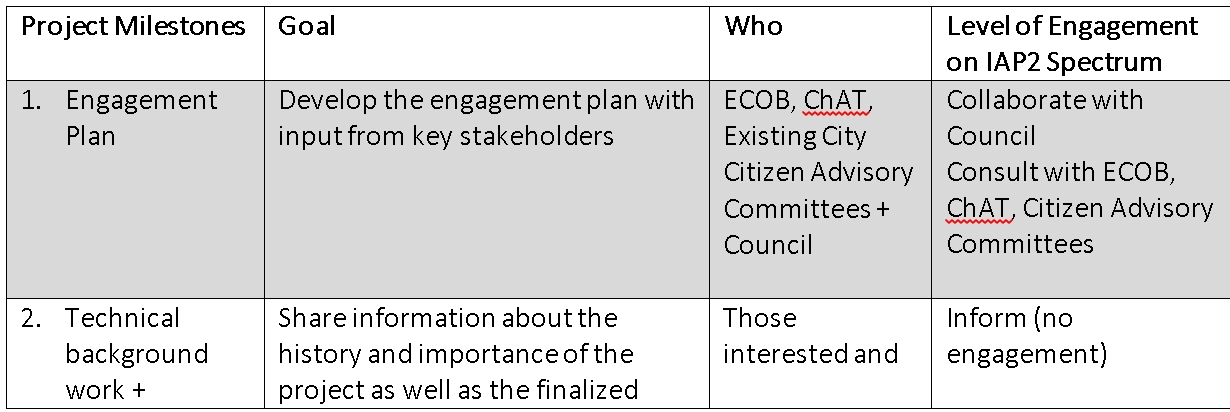  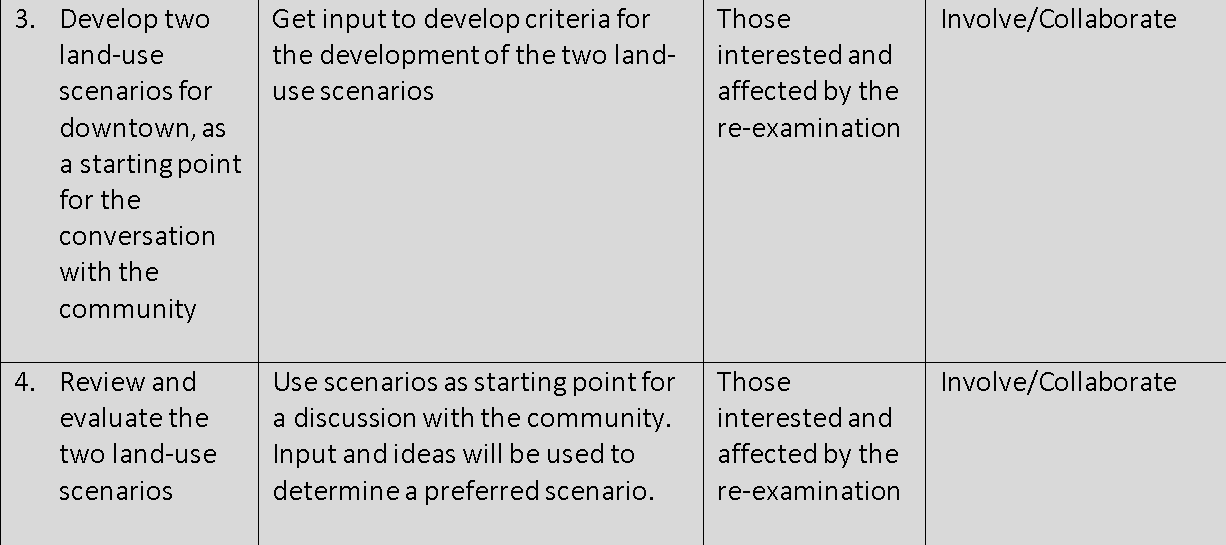 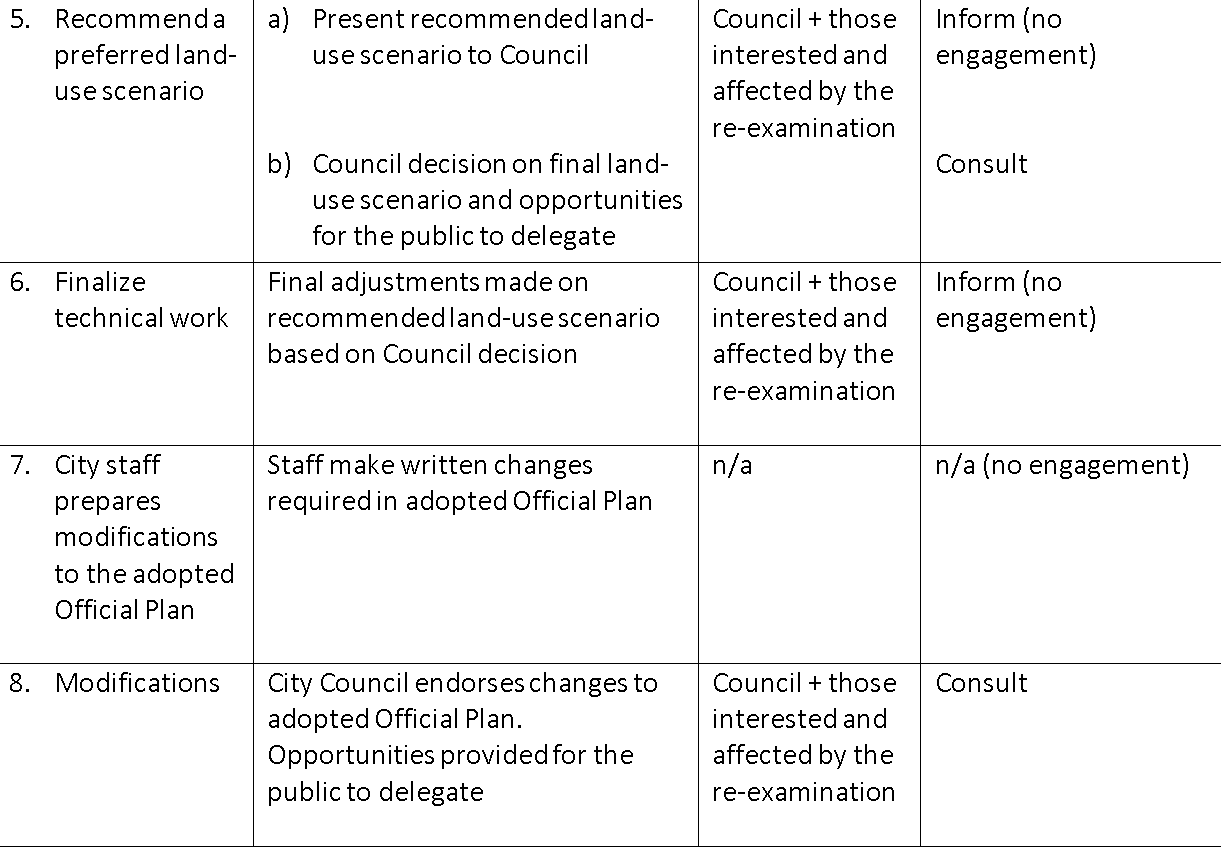 
The staff people leading the sessions began by seeking “input on the development of the engagement and communication plan.” Statements like that were not heard all that often. Thee Gazette is aware of at least one meeting with members of the community and a group of planners where a senior staff member shouted at one of the participants.
In the outline material people were given at this session the staff facilitators said: “Now that you know what is up for discussion, we also want you to know what is not up for discussion. We think these points are important in order to be up front about which aspects of this process cannot be influenced.
1. The re-examination is focused on the downtown only, not the whole city
2. Planning policy is guided by legislative requirements, such as Provincial Policy Statement, provincial plans including Urban Growth Centre policies, Halton Region Official Plan, Bill 108, Big Move/Metrolinx
3. The scope of work, timing and resources including the terms of reference, has been approved by Council through a staff report that includes the development of two land use scenarios as a starting point for the conversation with the community
4. Previous development approvals will not be revoked
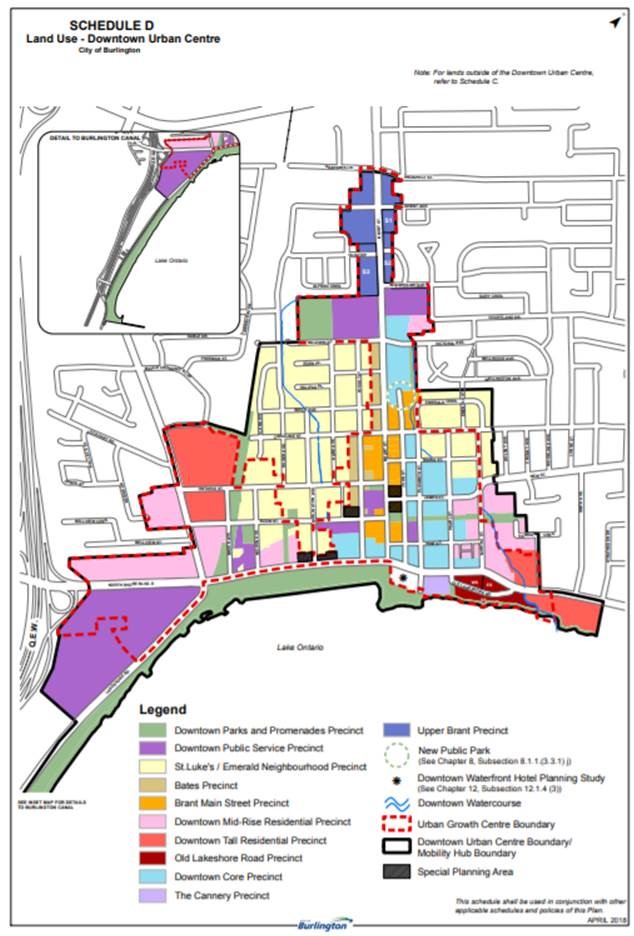 Coming up with a plan that creates a way to communicate with the public that wanted change in the way thee downtown core is grown in the future. 5. The proposed downtown plan and policies must be developed with the objective of being able to withstand possible appeals to the LPAT
6. The basis of the re-examination is the adopted Official Plan, not the current, in-effect Official Plan
7. The Interim Control ByLaw (ICBL) Land Use Study is a separate study
8. Halton Region is the authority that approves the City’s Official Plan and decides whether to approve any modifications endorsed by the City
9. Modifications must be endorsed by City Council by March 2020
10. The City doesn’t have control over the speed of change related to development, e.g. developers are guided by market forces.
The Scope of Engagement was explained:
“Through discussions at Council meetings, Council has identified a list of topics that need to be included in the engagement with the community. These topics are listed below.
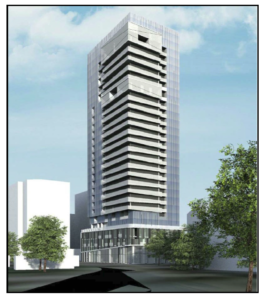 This is what citizens didn’t want. • The height of buildings
• Density of development
• Location of intensification
• Degree of change
• Options and trade-offs
• The development of policies that ensure development respects and maintains downtown Burlington’s identity/sense of place, and its role as a shared core area for all residents of the City
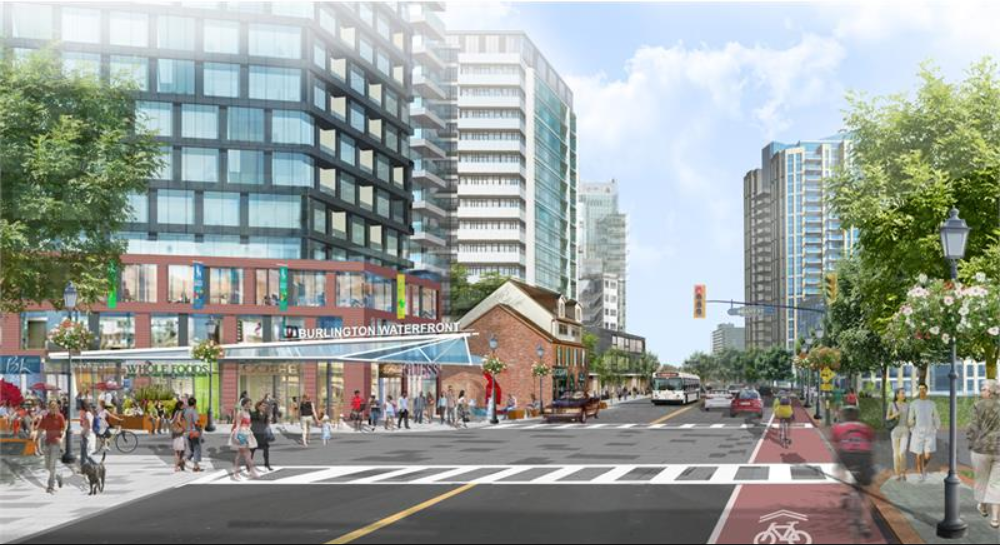 Is this what the downtown core is going to look like – how will it relate to the rest of the city? • How the downtown connects/relates to the rest of the City
• The use of mechanisms to achieve desired amenities and infrastructure (including office space, retail space, affordable housing, seniors’ housing, parks, open space, street trees, public spaces)
• The approach to policy development, e.g. the use of strictly defined development maximums or flexible development ranges
• Compatibility with established neighbourhoods that surround the downtown
• The development of policies to protect the waterfront, small retail spaces, and cultural heritage resources.
Participants were asked to share their thoughts on the list. They were asked if anything was missing?
The facilitator added: “Looking at the direction from Council, we want to talk to you about techniques, tools and communication approaches that will help ensure broad participation in the re-examination.
One of the exercises was for the participants to develop two land-use scenarios for downtown. They would gather input to develop criteria for the two land-use scenarios which will be used as a starting point for the conversation.
The sessions are taking place from Mid-July – mid-August 2019.
The participants were given a list of engagement techniques
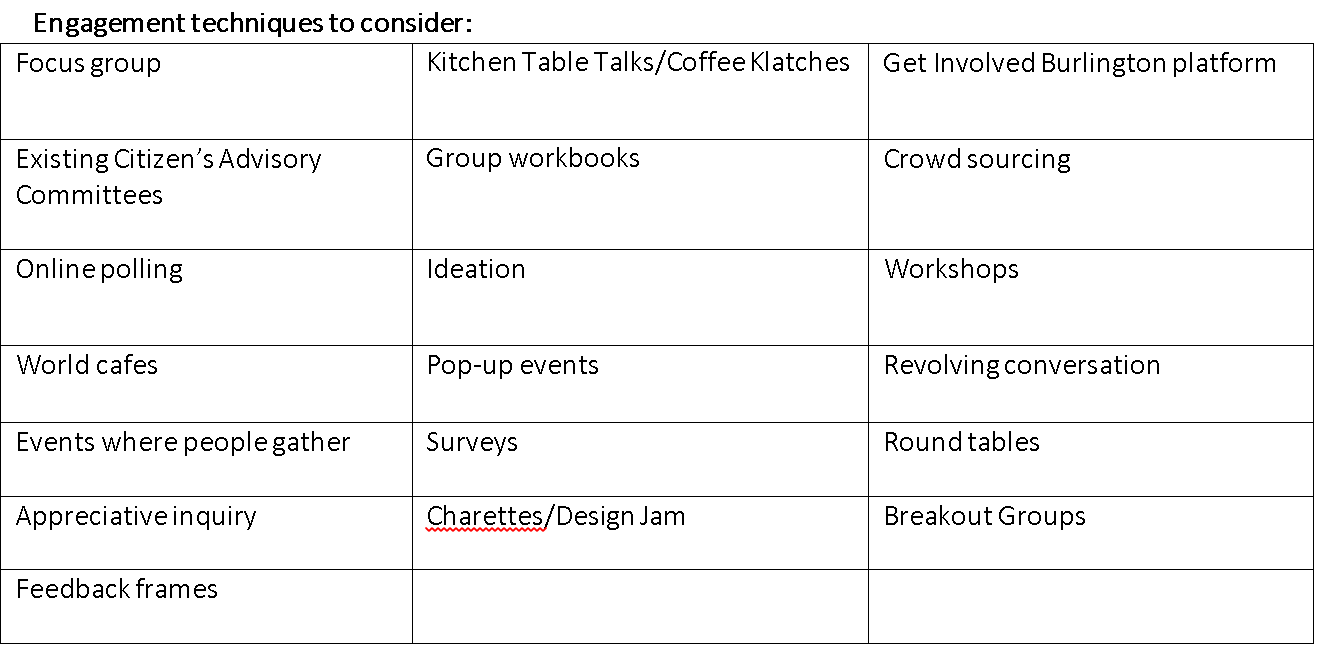
to consider and asked:
 The city used to hold public meetings on budget proposals – they were for the most part city staff telling the public what was going to be done with little in the way of feedback that got much further than the room they were uttered in. The initiative taking place now appears to be an attempt to change the way the city engages its public. • Which of these techniques do you feel would be most successful in gathering representative input from the community?
• Can you think of any others?
• Which of these techniques do you feel would be most successful in gathering representative input from the community?
• Can you think of any others?
“Thinking of the ideas you’ve provided; can you give us some guidance on time of day and days of the week that you think would be the most successful for gathering representative input from the community?
“To provide as many people as possible the opportunity to participate in the re-examination of the downtown policies, can you share ideas for communication approaches and outreach techniques that would be successful in reaching a broad section of the community? Have you seen other approaches that worked well?
“What would a successful engagement look like to you?
“In your opinion, is there any communication approach that should be avoided?
The ideas and feedback that come out of the sessions will be used by City staff to create an engagement and communication plan for the re-examination of the adopted Official Plan.
The approach that has been set out is as good as it gets. All the bases are covered and staff seem to be fully committed to the objective. This is not one of those ‘check off the boxes’ exercise.
During the hectic period during which debates were taking place in all six wards courtesy of ECoB – two Councillors could find nothing decent to say about the organization. Kudos to staff for inviting ECob into the conversations. They earned the right to be there.
Someone at city hall deserves a lot of credit for taking the direction the facilitators are on; it augers well for the kind of thinking that we should see in September.

 By Pepper Parr By Pepper Parr
July 22, 2019
Burlington, ON
It is the document developers just love – it covers a multitude of sins and can almost be used to say whatever you want it to say in a development application.
It was used to devastating effect in Burlington on a proposal for 26 storeys on land zoned for four to eight storeys – the developer got 24 storeys.
That document, the Provincial Policy Statement is about to undergo some changes.
The Provincial Policy Statement (PPS) sets out Ontario’s land use planning direction for:
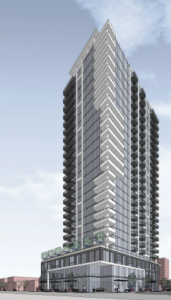 … and it was used to justify this structure.  The existing Provincial Policy Statement PPS was used to justify this structure …. Managing growth and development;
Ensuring the wise use and management of resources, such as farmland and natural features; and
Ensuring that public health and safety are protected – such as directing development away from flood-prone areas.
Municipalities implement the PPS through policies included in their official plans, zoning by-laws and local land use planning decisions.
The province is holding a 90-day consultation on proposed changes to the PPS. The proposed changes are focused to help:
Increase the supply and mix of housing by increasing land supply for housing to help people find homes close to where they work and give municipalities more flexibility to plan for a range of homes, like single-detached, townhouses, mid-rises and duplexes that meet people’s needs.
Protect the environment and public safety by encouraging transit-oriented development and ensuring municipalities prepare for the impacts of a changing climate while continuing to protect important natural features, including wetlands, wildlife habitat, and the Greenbelt.
Support certainty and economic growth by giving more flexibility to municipalities to ensure areas designated for employment are planned to reflect local needs and to help facilitate the conditions for economic investment, and to ensure that local infrastructure investments are efficiently used, and that protections for transportation and energy corridors for future needs are in place.
Reduce barriers and costs by proposing to add new policies that require municipalities to take action to streamline and fast-track development applications for housing and economic development proposals.
Support rural, northern and Indigenous communities by providing more flexible sewage and water servicing policies, enhancing municipal engagement with Indigenous communities on land use planning matters, and continuing to support the agricultural sector.
The consultation closes on October 21, 2019. Feedback is encouraged and may be sent by:
Submitting an email to planningconsultation@ontario.ca
Submitting comments on the Environmental Registry of Ontario at
https://ero.ontario.ca/pps in response to posting #019-0279
Writing at:
Provincial Policy Statement Review
Ministry of Municipal Affairs and Housing
Provincial Planning Policy Branch
777 Bay St., 13th Floor
Toronto, ON M5G 2E5
Fax: (416) 585-6870

 By Pepper Parr By Pepper Parr
July 16th, 2019
BURLINGTON, ON
The 2018-2022 Plan: From Vision to Focus is the City’s work plan that prioritizes key strategic direction from Burlington’s long-term 25-year Strategic Plan. From Vision to Focus details key goals and actions required to move priorities forward during this term of Council and was approved at Council last night.
 In the media release the city sent out there is very little in terms of detail. The Gazette put together a lengthy piece setting out what the city wanted to get done in each of the five focus areas. That article can be accessed HERE. In the media release the city sent out there is very little in terms of detail. The Gazette put together a lengthy piece setting out what the city wanted to get done in each of the five focus areas. That article can be accessed HERE.
City staff did a lot of work leading to the completion of the document that now takes on a life of its own. Council members were given the opportunity to talk at length on what they saw as the vision for the city; those conversations were one-on-one which was important.
There was a series of joint workshops with the 2018-2022 Burlington Council and the Burlington Leadership Team to reconfirm the specific focus areas and define goals and actions required to execute on the plan.
Burlington’s relationship with Strategic Plans in the past was disappointing. The Gazette got to look at documents that were decades old that were not much more than a collection of photographs accompanying clichés and bromides.
 The ideas were all over the map – it was the first time there was a deep dive Strategic Review exercise for the city in more than two decades. The 2010 Strategic Plan was a serious effort to pull staff and council together on a vision – it didn’t work out quite that way. When it came to using little coloured dots to indicate choices and preferences it became painfully clear that staff and council were not only not on the same page – they weren’t in the same room.
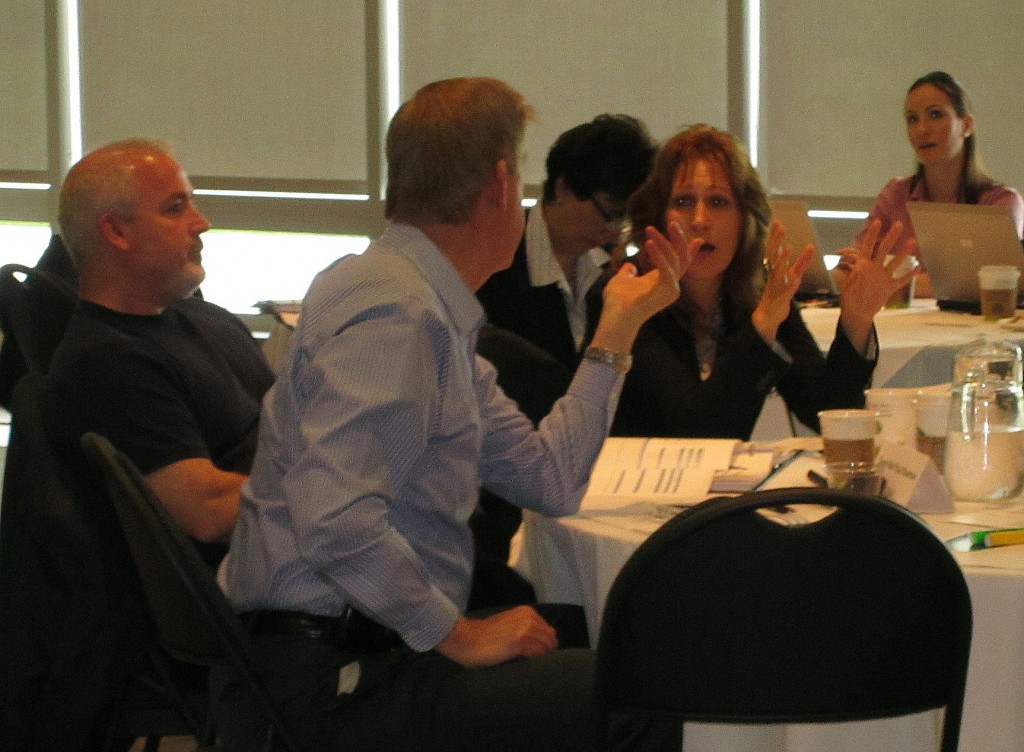 Councillor Sharman with his back to the camera faces off with Councillor Meed Ward at a Strategic Planning session in 2011 They work together more easily two elections later. The 2014 Strategic Plan was better but the leadership on Council just wasn’t there to ensure that the views of the elected were heard and made front and center.
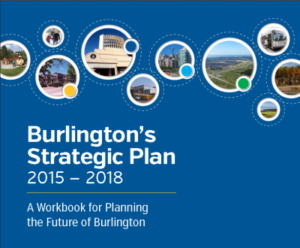 We started here … 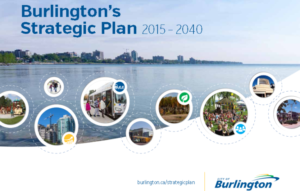 … grew into a 25 year plan. That changed when the Strategic Plan was made into a 25 year document rather than a four year term of council document. It was a huge step forward. There however does not appear to be any record of a debate on doing from four years to 25 years – it just got done.
The Strategic Plan has four pillars that were turned into focus areas for the V2V document – with a 5th added.
City resources will be aligned to ensure progress is made in the 5 identified focus areas:
• Focus Area 1 – Increasing Economic Prosperity and Community Responsive Growth Management (updated based on Council approval on July 15, 2019)
• Focus Area 2 – Improving Integrated City Mobility
• Focus Area 3 – Supporting Sustainable Infrastructure and a Resilient Environment
• Focus Area 4 – Building More Citizen Engagement, Community Health and Culture
• Focus Area 5 – Delivering Customer Centric Services with a Focus on Efficiency and Technology Transformation
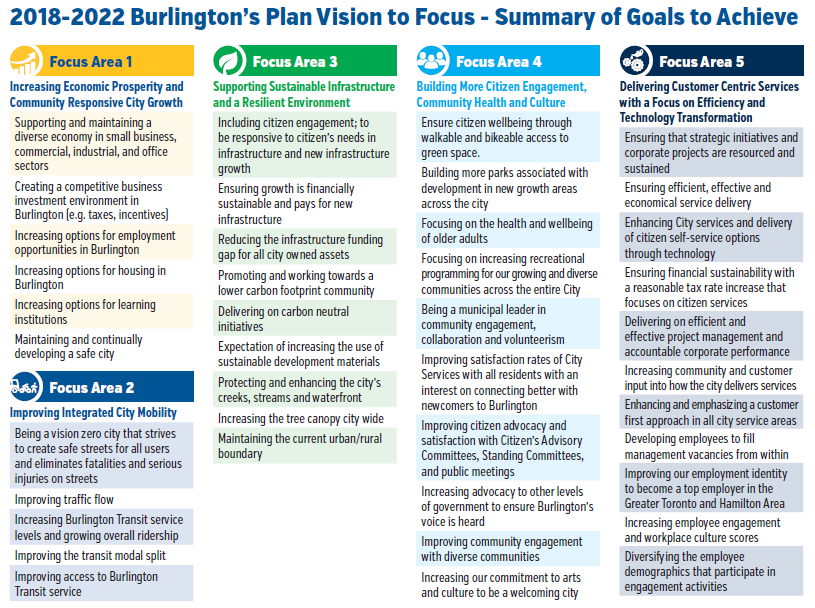 The vision and a summary of the goals that will get us there. “This plan is a living document. Other updates to this document are in progress and an updated version will be available September 2019. Of note, some initiatives identified in this plan may go beyond the 4-year term and will be carried over into future years for continued implementation.
“The 2018 to 2022 Plan: From Vision to Focus will be monitored and reported to Burlington Council on a regular basis and progress evaluated and reviewed. (It wasn’t clear during debates if the review was to be every six months or just once a year – what was very clear is that this initiative is in the hands of council and not something the planners get to keep to themselves. It is perhaps the most ‘political’ document this council has produced.)
“There may be changes along the way, such as: global, regional, and city circumstances changing, events occurring, and other levels of government influencing further updates to the plan document.”
V2F reflects what Council wants in a way that Grow Bold did not; if Council takes the document seriously it should serve the residents well going forward.
Some members of the current Council struggled with the level of detail. Others had interests that took them in a different direction. Others still had different ideas on what a council member is really supposed to do.
Mayor Marianne Meed-Wards said: “This work plan lays out what we want to focus on as a City and Council in the next four years to get us to where we want to be by 2040 (our vision).
This is a living document that will be re-calibrated year over year — we want to get the wheels in motion to make it easy to fulfill the matters that are top of mind among our residents: the tree canopy, green space, and growth and development.
“I believe there is an appetite for visionary aspirations among staff at the City of Burlington, and I can tell you the community is already there — they are ready for this. I’m proud of this plan and want to thank and congratulate staff on all the great work they have put together in it.”
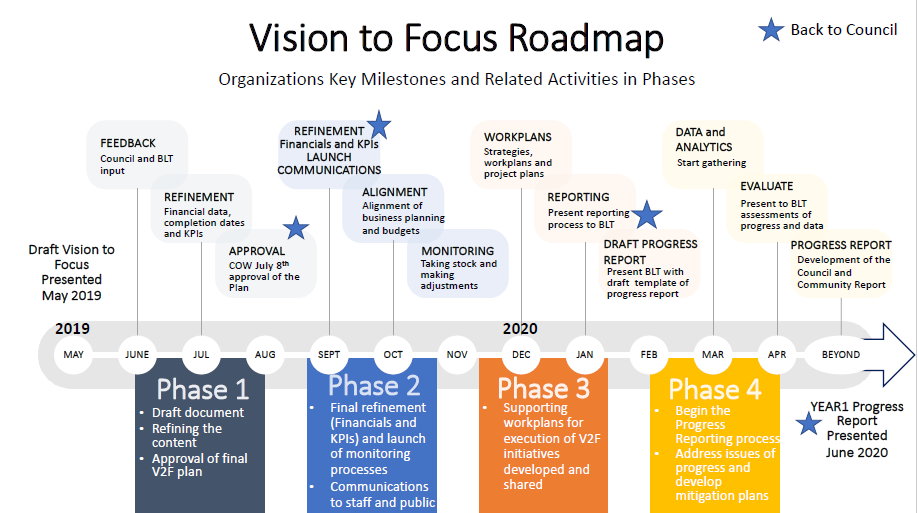 There is a road map with time frames. 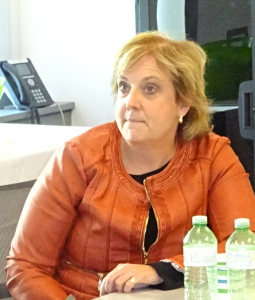 Mary Lou Tanner, Deputy City Manager, the woman who gave the city the Grow Bold concept said: “The commitment from the Burlington Leadership Team and Burlington Council to work towards common objectives in partnership with our community is at the root of this important four-year plan. Mary Lou Tanner, Deputy City Manager, the woman who gave the city the Grow Bold concept said: “The commitment from the Burlington Leadership Team and Burlington Council to work towards common objectives in partnership with our community is at the root of this important four-year plan.
“The City has clear focus areas and key actions we need to achieve”; that point is now at least clear.
“Our capable staff continue to work hard to move our strategic priorities forward so that our city sees the benefits and residents feel the positive impacts to their quality of life. Staff is committed to letting Council and our community know how this work is progressing and how we have moved the needle for Burlington. ”
Staff at this point is to a considerable degree a beleaguered bunch of people. The turnover rate is high – good people are seeking greener pastures – for good reasons.
During one of the presentation last week given by Director of Human Resources pointed out that Burlington is at the 50th percentile when its pay rates are compared with their peer groups.
Burlington is not paying people terribly well – the benefits are good – but the salaries are not attracting the best and the brightest.
The Escarpment and the lake are great attractions but the cost of housing means many of the younger people who are in that 50th percentile cannot afford to live in the city – and have to spend an hour or more getting to their jobs. The only upside is that parking is free.
Burlington is looking at ways to get to the point where staff are at the 65th percentile – something that is not going to go over all that well with the voters.
Background links
burlington.ca/vision2focus
Related new story:
V2F – in depth.


July 13th, 2019
BURLINGTON, ON
Globe and Mail editorial has a viewpoint on both the character and built form of a community that sheds some light on what Burlington faces. Several words have been set in bold by the Gazette.
 The defining feature of North American cities is the single-family detached home. It is the least efficient way to house people, yet municipal zoning laws have historically served to ensure its primacy. The defining feature of North American cities is the single-family detached home. It is the least efficient way to house people, yet municipal zoning laws have historically served to ensure its primacy.
It’s time for change – and urgently so. The cost of housing in Vancouver and Toronto is stratospheric, and even in more affordable cities like Calgary, Ottawa and Montreal, it is way more expensive than a generation ago.
Expensive housing hinders economic growth. Cities are the engines of the economy but are increasingly inaccessible, and the financial challenge of moving to Canada’s biggest cities, to study or to pursue a career, is daunting.
The high cost of housing also leaves a generation of young Canadians facing the prospect of a lifetime of renting, never able to build equity, or shouldering a worrisome amount of mortgage debt that will take decades to pay off.
There are many factors at play – British Columbia has done much to address the issue of foreign speculators – but the core problem is the allocation of land. Our zoning is forcing cities to expand endlessly outward, by preventing them from building up.
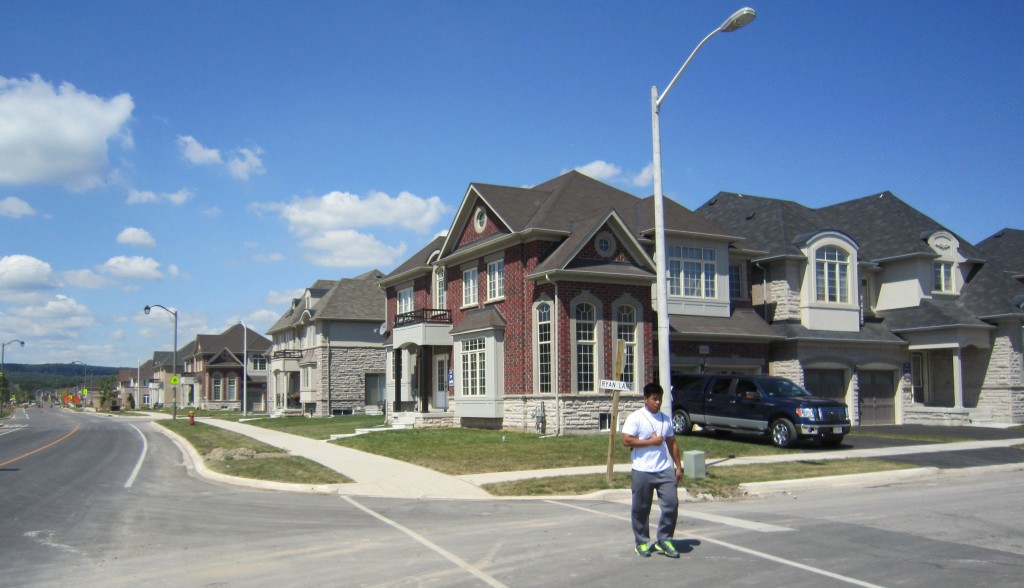 Alton Village The bulk of municipal land zoned for housing – at least two-thirds of it in many cities – is reserved for detached homes, while multiunit housing is restricted to small designated areas, generally in the city core but often far beyond or on abandoned industrial lands. That leaves the supply of housing artificially limited, particularly in areas near transit lines and city centres.
Meanwhile, owners of detached homes, who have the ear of elected officials, argue the so-called character of their neighbourhoods must not be disturbed. The long-standing status quo serves them well, effectively enriching them through government policy.
But the argument about character is a smokescreen. Where there is a neighbourhood of single-family homes, there was once a forest or a field. No one mourns the lost character of what had been there before. Character is wielded as a weapon against change. As Globe and Mail architecture critic Alex Bozikovic put it in June, “’Character’ means exclusion.”
There is an answer. It’s called the missing middle: small-scale, multiunit housing, from duplexes and triplexes to mid-rise apartment buildings. The missing middle is not a fix-all, but it is an essential step forward.
Minneapolis is a beacon of possible change. Last December, city council passed a plan that ended the dominion of single-family zoning. It is regarded as the first of its kind in the United States, but it’s hardly radical. Where a single house was previously permitted, a building with three units, a triplex, is now allowed. The rallying cry has been “Neighbors for More Neighbors.”
Oregon was the next to move. State legislators in late June passed a bill that will remake single-family zoning to allow fourplexes in cities of more than 25,000 people, and throughout the Portland region.
In Canada, the prospect of change is depressingly dim. In the City of Vancouver, a one-year trial allows applications for duplexes in single-detached zones. This is in a region where the typical house costs $1.4-million and median annual household income is $73,000. Meanwhile, city council is ponderously debating whether to get work started on a new citywide plan that will take three years to complete.
This is the opposite of urgency.
In Toronto, the story isn’t much better. The province in June approved new rules for downtown and midtown Toronto, after reworking plans the city had submitted, but the geographic reach of change is limited. There is no serious talk of rezoning what’s dubbed the “yellow belt” – the 70 per cent of available land limited to single-family homes.
The moves in Minneapolis and Oregon are interesting, but modest compared with what is needed in Vancouver and Toronto. Small apartment buildings – of three, four or five storeys – would go a long way. Then there are important questions about low-income housing and rental housing. And there’s the issue of how cities should benefit from increases in land values sparked by zoning changes.
But first we need some political will. There are 10 million Canadians between the ages of 20 to 40, the time of life when people make a first foray into home ownership. Canada’s zoning rules are antiquated. They should be rewritten to serve the present, not the past.

 By Pepper Parr By Pepper Parr
June 27th, 2019
BURLINGTON, ON
The Official Plan, one of the most misunderstood documents the city relies on – it is a dynamic document that is expected to react to changes taking place in the community and the wishes of the residents. The document is required to react to development proposals.
The Planning Act allows anyone with a development idea to approach the city’s Planning department and pitch them on making changes to the Official Plan and the zoning in place on a property.
The Planning department advises the developer but the developer still has the right to file an application which staff then have to issue a recommendation on that goes to city council for a yes or a no. And if the developer doesn’t like the response they get from city council they can appeal to the Local Planning Act Tribunal.
That’s the way the system works.
During 2018 the then city council approved a new city plan. Much of the public didn’t like the new plan – and it became the issue the October election was fought over.
A ward Councillor, Marianne Meed Ward, challenged the Mayor – won the Chain of office and set out to right what she thought was wrong.
The Regional government, which had to approve the new Official Plan chose not to approve what the city had submitted – so the plan had to be re-worked. The Region gave the new Mayor a gift telling her that the city could make other changes in the document – that they weren’t limited to fixing the few really minor problems the Region found.
That was all the new Mayor needed. She told the Planning department to get rid of the Grow BOLD approach they had taken to development and to re-work the plan.
How is that going so far?
Here is the time line and the numerous steps, hoops and hurdles that have to be dealt with.
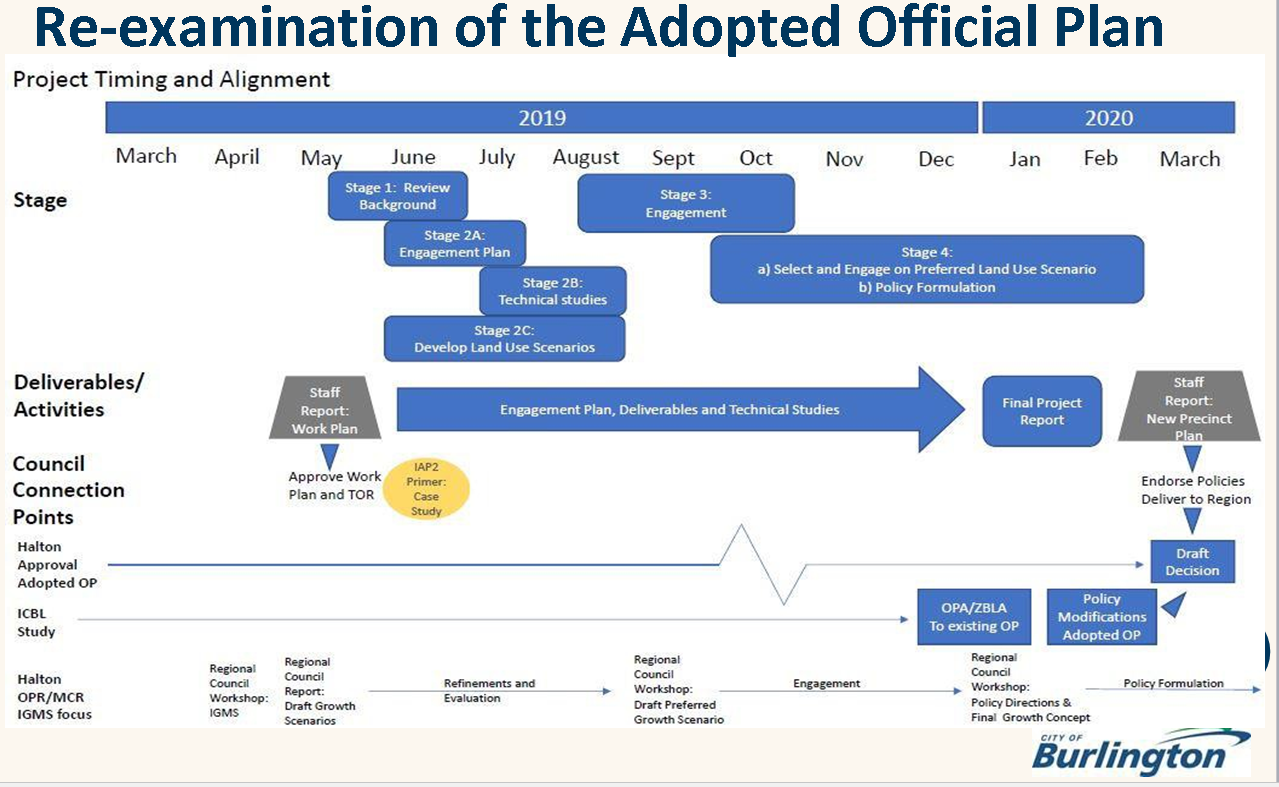 Completing the re-examination of the Official Plan that was approved by the city but not approved by the Region is rubbing up against the Interim Control Bylaw that is in place for a year. Getting a new plan is place is a serious challenge.  Ward 2 Councillor Lisa Kearns Ward 2 Councillor Lisa Kearns told a constituents meeting last week that “Work is underway with our consultant based on the terms of reference presented on May 21st. The terms of reference were developed at a March 18th workshop; the Official Plan direction to conduct the study was given on February 7th.”
They have their marching orders and by now the Planning department knows where this council wants to go.
Let’s see how this works out.

 By Pepper Parr By Pepper Parr
June 26th, 2019
BURLINGTON, ON
 The development will be the first of the really high rise buildings in the downtown core. All the hubbub over what should be done with Civic Square is going to amount to a little less than a hill of beans once construction on The Gallery – the 24 storey development that has been approved for the north east corner of Brant and James.
The developer has applied for and been given Shoring and Excavation permits and expect to begin the demolition of the building sometime in the late summer.
The day the first back hoe digs into the existing structure could well be the beginning of a five year time frame for a continuous run of construction work on Brant Street.
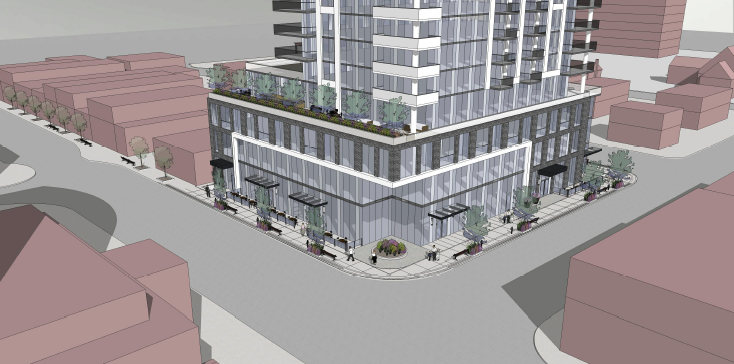 When completed the building will be the beginning of the change in the downtown core – until then it will be havoc for people who live and shop in the area. Imagine Sound of Music on a construction site. The proposed development for the south east corner of the intersection has been approved for 17 floors – the developers of that project want the same as The Gallery – 24 floors. They have appealed to the Local Planning Act Tribunal. Those who watch this process carefully can’t see any way for the city to hold the development at 17 floors – which is what most of the previous city council was prepared to live with.

 By Staff By Staff
June 20th, 2019
BURLINGTON, ON
 We Love Burlington pressed Burlington MPP for comment on why she supported Bill 108. We Love Burlington pressed Burlington MPP for comment on why she supported Bill 108.
Jane McKenna provided a detailed response that is set out below. We Love Burlington has said they will review and respond to McKenna at some later date. We expect the Mayor of Burlington might have something to say as well.
The Gazette is giving you what McKenna had to say without any comment or analysis.
 Burlington MPP Jane McKenna “I want to clarify some of the issues you have raised in your submission on Bill 108. Your underlying assumption appears to suggest the province is trying to curtail local planning authority rather than ensure the best planning outcomes. Nothing could be further from the truth. I want to be clear that the Ontario government wants to improve the local planning process to facilitate better and faster community consultation, a more open community benefits strategy that requires more local input and ensures that growth pays for growth.
“Your submission on Bill 108 and our new Affordable Housing Supply plan was one of the more than 2,000 public submissions that were considered prior to drafting the plan and supporting legislation.
“Despite your claims to the contrary, extensive consultations, in which you participated, took place in the development of the More Homes, More Choice Act, 2019. Within months of the June election, Municipal Affairs and Housing Minister Steve Clark began consultations in the development of the Ontario government’s new Housing Supply Action Plan. Minister Clark met with local Mayors at the Association of Ontario Municipalities, (AMO) conference last August in Ottawa and at the Large Urban Mayor’s Caucus of Ontario, (LUMCO) last month in Toronto. In fact, at the recent LUMCO meeting, the Minister advised that if Bill 108 passed, the Ministry would be consulting further on the Community Benefits Formula. Last week, the Minister sent a follow-up letter to all heads of Municipal Council in advance of a June 14th meeting with AMO members.
“Many organizations including the Centre for Urban Research and Land Development at Ryerson University have published research demonstrating that one of the key roadblocks to building an appropriate mix of housing in the GTHA that supports vibrant, walkable, complete communities is the land-use planning approvals process.
“In the City of Toronto, by way of extreme example, it takes on average 10 years to get a building approval. This is a system that has been mired in excessive red tape, with regulations and processes added to processes. These were often attempts to satisfy and balance the adversarial needs of the development community and neighbourhoods that are often resistant to change. Add local politics and politicians who do not vote against their constituents’ wishes in support of good planning (that has proven to be unpopular) and you have a recipe for paralysis.
“How are we to meet our responsibility to solve the very serious housing crisis that is preventing our children from being able to afford to rent or own in their home town? How are we to manage the influx of more than a million newcomers to the GTHA by 2031 if not by encouraging the private and non-profit sectors from building a variety of new housing supply through legislation?
“You complain that Burlington has lost control of land use planning. You are correct. Here’s why.
“Burlington City Council has not produced an updated Official Plan in about 25 years – since 1994. One could suggest a variety of reasons for this. More recently, as development pressures have increased, politics have no doubt played a role.
“When the planning system is clunky, expensive, time consuming, outdated and adversarial it’s time for process adjustment.
“The Province’s Growth Plan is guided by the desire to build compact, vibrant and complete communities. It does not replace local official plans, but it does provide a framework for growth that requires municipalities to update their Official Plans to ensure compliance with the Places to Grow Act. Oakville updated their Official Plan in 2009 to conform, and Milton amended their 1997 Official Plan in 2010 to meet these provincial policy changes. Burlington’s 25-year-old Official Plan doesn’t respond effectively to the growth pressures of 2019. An outdated Official Plan does not work for our communities, our children who would like to be able to afford a home in town, our investment community or our new residents. Our OP reflects a time when Burlington was 50,000 people smaller, back when the average price of a detached house was about $200,000.
“Our Official Plan doesn’t take into account the most significant changes to planning policies in Ontario’s history. That is a big part of why, more often than not, Burlington has surrendered local planning decisions to both the old OMB and new current LPAT. To take back some local control, Burlington needs to act quickly to consult with residents and adopt a new Official Plan that complies with the Places to Grow Act and will be approved by Halton Region.
“Municipal governments are expected to be accountable and adaptable to legislative and regulatory changes. Change only becomes dysfunctional when it is not effectively managed. We believe that assessing and planning for operational and financial impacts is within the capability of the City of Burlington. The municipality will decide whether to raise taxes, reduce services or increase borrowing for capital expenditures as necessary.
“We have a housing supply crisis in Ontario that is being addressed by More Homes More Choice. Our role as government is to create the conditions where home builders can build more of what communities actually need. Our plan includes changes that would make it easier to build a mix of housing – town homes, apartments, condos, single family homes – for people to rent or own. You are incorrect when you write that developers can build whatever, wherever they want.
“The GTHA – Burlington included – is the fastest growing region in Ontario and one of the fastest growing metropolitan areas in North America. Good planning is vital to creating strong healthy communities for our kids and our grandkids.
“As part of Bill 108, changes were made to the Planning Act to simplify how municipalities collect funds for community benefits like parks and daycares. Minister Clark has been clear that one of our goals in establishing the new community benefits approach is to maintain municipal revenues and ensure appropriate infrastructure to support growth.
“We want municipalities to recover similar revenues from community benefits charges to what they have collected from development charges for discounted services, density bonusing and parkland dedication. We will develop a cap that protects vital revenue streams.
“Let me be clear – the provincial government firmly believes that growth should pay for growth. In passing Bill 108, we are moving towards a system where developers, not taxpayers, fund growth.
“It is important that municipalities have the resources to support complete communities and give the public the opportunity to provide input through public consultation. This does not happen in todays Section 37 negotiations.
“In April 2018, Burlington’s Mayor said that, (under the pre-Bill 108 system) “residents don’t have a seat at the table when negotiating Section 37 Community Benefits. The Ward councilor is consulted, but also doesn’t have a seat at the table, and their input can be ignored.” Our government agrees that Section 37 was not serving the best interests of local residents. That’s why we are working to ensure there is more public input into community benefits decisions through a municipality wide community benefits strategy.
“Again, let me be clear – we are not removing any community protections. Our government will continue to consult with our municipal partners on the development of a community benefits charge that takes the politics out of planning.
“Our plan also includes changes to the Local Planning Appeal Tribunal (LPAT) – formerly the Ontario Municipal Board – and the main adjudicator of land use planning disputes in Ontario. Right now, the tribunal has a backlog of legacy cases from the old Ontario Municipal Board. A two-to-three year appeals process, at a time when Ontario is in a housing crisis – is unacceptable.
“Our estimates from the Ministry of the Attorney General show that over 100,000 housing units are caught up in legacy cases at the tribunal. That’s 100,000 desperately needed homes that can’t get built – or three years worth of construction in Ontario waiting for approval.
“Thanks to the Attorney General’s support, we are also adding 11 new adjudicators, a 45% increase, to tackle the backlog of cases in the next 18 months and prevent future backlogs.
“We’re encouraging mediation to reduce the number of cases that actually proceed to a formal hearing and we are moving towards a cost-recovery model where developers will pay more for the system.
“On the Endangered Species Act, our legislation takes a smarter approach to recover species, including new methods for protecting species at risk due to disease, fungi or invasive species.
“Currently, after an applicant looks at alternatives to avoid a species at risk and mitigates any risk their project may have on that species, they are required to develop a plan to benefit the species through actions like habitat creation. However, some species like the Butternut Tree and several bats are decreasing due to factors harder to control or mitigate such as disease, and invasive species.
“The current Act doesn’t allow the most effective path to resolve these issues. Our changes will allow applicants who have considered alternatives and put in place mitigation measures to pay a charge to the Species At Risk Conservation Trust instead of completing other onerous requirements, such as expensive field surveys that could cost $30K per species.
“This will help enable positive outcomes for species that are decreasing due to disease, invasive species or other reasons by accumulating payments and leveraging the collective resources for more strategic, coordinated and larger scale actions.
“Ontario is committed to ensuring Ontario’s best-in-class endangered and threatened species protections include advice and species’ classifications from an independent scientific committee and modern approaches to enforcement and compliance; species and habitat protections; and recovery planning.
“During the past decade of implementing the ESA, we have heard what works well and what could work better.
“The proposed changes posted on the Environmental Registry will enhance government oversight and enforcement powers to ensure compliance with the act and improve transparent notification of new species’ listings.
“Species assessment and classification decisions will continue to be made by an independent scientific committee – the Committee on the Status of Species at Risk in Ontario (COSSARO). The list of species at risk will continue to be updated automatically, based on the independent science-based assessment process.
“Ontario is also proposing to create Canada’s first independent agency to be called the Species at Risk Conservation Trust, to allow municipalities or other applicants the option to pay a charge to the Agency in lieu of completing certain on-the-ground activities required by the act.
“Applicants would still seek a permit and need to fulfill on-the-ground requirements, including considering reasonable alternatives for their activity and taking steps to minimize the adverse effects of the activity on the species at risk.
“Bill 108 is important legislation to solve one of the most pressing and urgent problems of our time – a shortage of housing stock has driven prices up making homes unaffordable for many families. With on going global urbanization Burlington, as part of the GTHA, is experiencing extraordinary development pressure as more and more young people want to live and raise their families here. We can’t stop growth but we can manage it successfully with intention and good planning.
“This is a municipal responsibility. We all love Burlington. We can watch it transform into the kind of community we want – one with a vibrant downtown, with plenty of families and couples walking and cycling to pick up fresh groceries or to meet some friends at a café. The air will be cleaner because we will be driving less, we will be healthier because we’re walking and cycling more.
“This is a long term vision. We need to extend our view 20, 30, 40 years into the future. The next generation of mobile young people are looking to live, work and play at home.
“This is legislation that is important and integral to our well being and success as a community. We have much to celebrate and I welcome divergent views and thoughtful criticism.
“Leadership and dialogue would be the most advantageous approach for the municipality and the provincial government. The people of Burlington deserve no less than our honest commitment to do the hard work necessary to solve the housing crisis in the GTHA and beyond.”

 By Pepper Parr By Pepper Parr
June 19th, 2019
BURLINGTON, ON
Do you remember what happened to the van that the Premier wanted outfitted with a mini-fridge and a leather couch? The blow back was pretty fierce and the Premier has had to do with staff driving him about in an SUV.
 And then there was the friend that the Premier wanted to appoint as Commissioner of the Ontario Provincial Police. The blow back on that one was even fiercer. Someone else got that job. And then there was the friend that the Premier wanted to appoint as Commissioner of the Ontario Provincial Police. The blow back on that one was even fiercer. Someone else got that job.
 Buck a beer fell off the radar screen. Buck a beer fell off the radar screen.
The plans to limit the support parents with autistic children got was also changed after the public stood up and said – not for us.
The current elephant in the room is Bill 108 which threatens to cripple and have a devastating impact on how municipalities deal with the services they are expected to deliver.
We learned on Monday that Mayor Meed Ward was to take part in a conference call with the Minister of Municipalities and Housing – he is said to want to hear is what the municipalities don’t like and what they are proposing in the way of changes.
City Manager Tim Commisso was to take part in the conference call.
The Bill was introduced to the Legislature and passed and made law in less than 40 days.
The municipal sector was gob smacked, stunned and in a state of shock.
The Bill would make it close to impossible for the municipal sector to do their jobs the way they believe the public wants.
No word yet on what was said during the conference call.
But the pressure is building and we now know that this Premier will buckle – so keep up the pressure.
Summer is when the municipal politicians meet with their federal and provincial counter parts. The pressure on the provincial government at the AMO (Association of Municipalities of Ontario) conference will be immense.
Related news stories:
What Bill 108 will do to us.
Hersh on what Bill 108 could do to Burlington

 By Penny Hersh By Penny Hersh
June 17th, 2019
BURLINGTON, ON
BILL 108 – It is a definite “wake-up” call for Municipalities. I am probably in the minority, but perhaps it is needed. I have watched the Planning Department not be able to process an application in 210 days – WHY! Some of the answers provided by some city planners were “we had an understanding with some developers to allow us to work together and not be concerned about the time frame”. Is this the way to do business?
 The ADI Nautique development on Lakeshore at Martha, I guess not because the City has been taken to the OMB/ LPAT for non-decision and with regard to the ADI Development on Lakeshore/Martha failed to defend its position. I doubt that ADI ever expected to get 26 storeys on that site.
The claim that the new 120 days does not give Municipalities enough time – perhaps the process the planning department is using is flawed. Why meet, as we have been led to believe, individually. Have all the players in the room at the same time – and have an understanding of who has to do what with definite time frames.
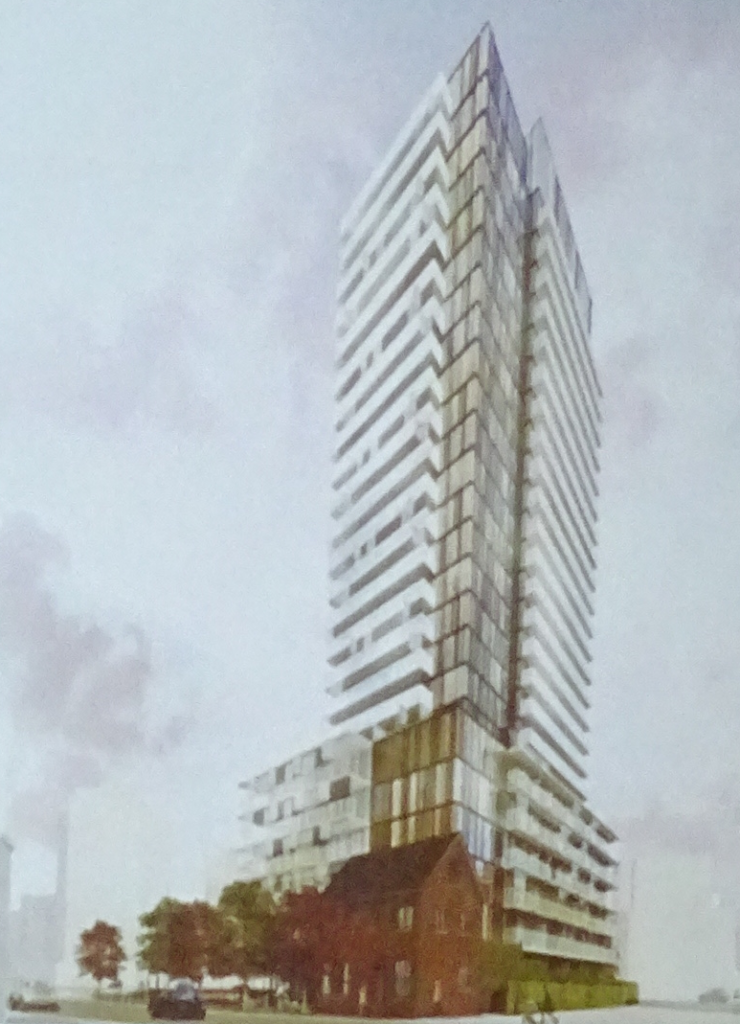 The sky appears to be the limit for a proposed development on Old Lakeshore Road across from Emmas Back Porch. Note the scale with the two storey heritage structure that the developer proposes to keep. What I have heard at Council Meetings from the planning department is that the wind, the shadow, the parking , and transportation studies etc. have all been completed and the development application is “good to go”. Every development application is taken as a one off – not looking at the other three applications in the same area that are asking for the same if not more.
Try walking on Lakeshore across from the Bridgewater Development – we now deal with a wind tunnel that on days makes it almost impossible to walk. We have traffic congestion on Lakeshore Road when at certain times there are long lines of cars trying to get off of Lakeshore ( and there are no accidents anywhere), and Bridgewater is not completed. Potential owners have been told that their move in date is now June 2020. Residents get to look at this unfinished construction for yet another year. ADI is scheduled to start construction on the 26 storey condo on Lakeshore/Martha shortly. All those studies and we are dealing with a canyon effect on Lakeshore with only one development partially completed, and not occupied.
We have insufficient parking for condominium owners and their guests. Anyone who cycles along Lakeshore and in the downtown takes their lives in their hands. Sharrows on narrow streets do not provide a safe place for cyclists. New developments with less retail space does not make Burlington the “most livable , etc. city” that is always being touted. We have enough nail and hair salons, we need retail that will keep people from using their cars.
 We have a public transportation system that does not meet the needs of the residents and certainly will not prevent people from using their cars. Free transportation from 9-2:30 Monday-Friday for seniors, while a nice thing to offer, is not the answer. It is a band aid approach to a more serious issue. Did you know that if someone takes a Handi-van into Hamilton, they have to change vans and get on a Hamilton Handi-Van to complete the journey? People who are eligible to use the Handi-Van have mobility and other medical conditions – and they have to change vans in all kinds of weather. Municipalities should have been working together, but they have not. We have a public transportation system that does not meet the needs of the residents and certainly will not prevent people from using their cars. Free transportation from 9-2:30 Monday-Friday for seniors, while a nice thing to offer, is not the answer. It is a band aid approach to a more serious issue. Did you know that if someone takes a Handi-van into Hamilton, they have to change vans and get on a Hamilton Handi-Van to complete the journey? People who are eligible to use the Handi-Van have mobility and other medical conditions – and they have to change vans in all kinds of weather. Municipalities should have been working together, but they have not.
Is it really the responsibility of a developer to provide affordable housing? Perhaps Burlington should have used the money they spent on the Pier to provide some affordable housing? It’s all about priorities and “legacy projects”.
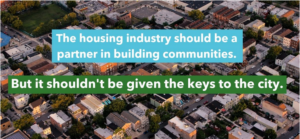 For a few years I have said that the OMB/LPAT has to go. I now question if all Municipalities are able to act alone to meet Provincial Mandates. Developers are in the business to develop. It is the responsibility of Municipalities to have in place an Official Plan that meets the mandates of the Provincial Government. Some municipalities seem to have done this. It seems, unfortunately, that Burlington has not, and I question if any new Official Plan that is passed will stand the test. For a few years I have said that the OMB/LPAT has to go. I now question if all Municipalities are able to act alone to meet Provincial Mandates. Developers are in the business to develop. It is the responsibility of Municipalities to have in place an Official Plan that meets the mandates of the Provincial Government. Some municipalities seem to have done this. It seems, unfortunately, that Burlington has not, and I question if any new Official Plan that is passed will stand the test.
We are ill-prepared to deal with what is coming down the road, and complaining and blaming others is definitely not the answer. Things have changed.
Get your house in order. Hire people who can do the job, and get rid of those who cannot. This is how business operates in the real world.
 Penny Hersh was part of the driving force that created ECoB – Engaged Citizens of Burlington. She serves at the co-chair of ECoB Penny Hersh was part of the driving force that created ECoB – Engaged Citizens of Burlington. She serves at the co-chair of ECoB

 By Roland Tanner By Roland Tanner
June 12th, 2019
BURLINGTON, ON
It is eleven months since this council considered the application for 409 Brant Street.
At that time 24 storeys was a new and unwelcome maximum, blowing past the maximums set out in the then newly adopted Official Plan.
That was just the beginning. Since then we have seen multiple proposals come forward which approach 30 storeys.
ECoB – Engaged Citizens of Burlington hope and expect that Council’s eventual decision on this building, which will not be for some time, will be not to approve it in anything remotely like it’s current configuration. That will be the correct decision, and it is the decision the voters expressed their wish for last year. Sadly, however, we also need to acknowledge the likely futility of that decision, whenever it comes.
Because this application is about who controls planning in Burlington.
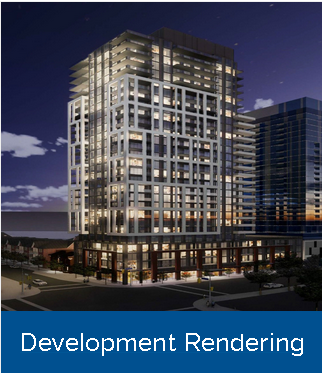 This Carriage Gate development will inevitably be appealed to the new LPAT/OMB, an un-elected, un-answerable, faceless, undemocratic agency of government which will decide Burlington’s fate on this development, as it will on most of the other developments which will be coming to Council in the months and years ahead. With the passing of Bill 108 into law and the return of the rules of the old OMB, but with slashed timelines, the minor improvements in planning procedure achieved by the introduction of the LPAT have been lost. This Carriage Gate development will inevitably be appealed to the new LPAT/OMB, an un-elected, un-answerable, faceless, undemocratic agency of government which will decide Burlington’s fate on this development, as it will on most of the other developments which will be coming to Council in the months and years ahead. With the passing of Bill 108 into law and the return of the rules of the old OMB, but with slashed timelines, the minor improvements in planning procedure achieved by the introduction of the LPAT have been lost.
A de novo hearing can enforce any decision it likes on Burlington, and precedent suggests the tribunal will not show any interest in the years of work staff and council have put into developing a vision for downtown.
To deal specifically with the problems with this development, I could, as so many have done on other occasions, talk about concerns with wind studies and setbacks, traffic effects and heritage protection. But I would simply be repeating what we’ve all heard many times before.
Certainly this building is inappropriate for downtown. It has hardly any stepbacks. The 45 degree angular planes across Pearl and Lakeshore run smack-dab into the 29 storey vertical wall the building creates at about the 8th floor.
All the design elements in the world to break up the tower’s appearance cannot hide the fact that this it is attempting to fit the most units it possibly can on a restricted lot size. It will worsen what has already become a problem area for wind on Pearl. It will be another large block in what has become the Lakeshore Chasm, a high-walled concrete tunnel channeling wind and traffic into our downtown.
It is an application, which if successful, will drive another nail into the coffin into what was once a promising urban promenade between Pearl, Old Lakeshore Road and Spencer Smith, losing a large percentage of the lake views that set Burlington apart from other cities.
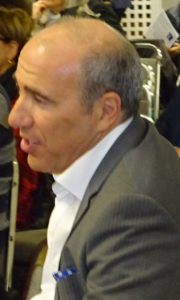 Carriage Gates Homes president Nick Carnacelli We have to recognize what this proposal is: it is a statement that Carriage Gate Homes considers the wishes of Burlington City Council and the democratically stated wishes of the residents of Burlington to be irrelevant.
They recognize that the power lies elsewhere, and their application has been designed with that in mind. And that was before Bill 108 became law. It is designed to be negotiated at LPAT, not to be approved by council. The Interim Control Bylaw, while allowing the City time to work out its own approach to downtown planning, is likely to be simply a delaying process.
However, and council can correct me if this understanding is wrong, we believe developers can still submit their appeals to LPAT even while the ICBL is in place. The city’s greatly reduced timelines are not changed.
This is a bleak picture, not just for those who want to see a reasonable and balanced approach to development in Burlington, but for anyone who believes in local democracy. Urban planning is now the preserve of whoever can pay for the best lawyers. Millions upon millions of dollars are being wasted – money that could make developments more affordable, and money that the City desperately needs to make up for the revenue it is losing under Bill 108. Ironically, In ECoB’s discussions with developers, it seems there’s one thing we can all agree on – the appeals process is a costly waste of time for all parties. Moreover, it is a process which most other provinces in Canada avoid completely.
So we need to urgently address the few things that can be done in Burlington to reduce the focus on downtown, and which the province has made clear are within the city’s powers to do.
First. ECoB urges council to do all it can to immediately remove the Mobility Hub designation from downtown.
Secondly, also founded on information received from the province, we urge the City to explore everything it can to consider changing the boundaries of the Urban Growth Centre to focus on Burlington’s real transit-corridor around the Go Station and Fairview and to work for that to be adopted in the next Regional Plan.
Without doing so, ECoB believes whatever changes the city makes to the Official Plans and zoning are largely irrelevant. The expectations of development in the Urban Growth Centre will always trump the limits made by Official Plans in the eyes of LPAT/OMB.
Thirdly ECoB urges council to start doing everything it can to engage the leadership of other cities in a campaign for renewal in municipal authority. It is a campaign that needs to persuade all political parties to put local democracy and root and branch reform of the provincial planning process on the agenda. Local planning, by cities in partnership citizens, is literally the only way in which we have ever built cities we can be proud of.
Finally, ECoB urges Council not to approve this development when it eventually comes before them, and to continue to make a case at every level for the implementation of a democratically informed planning vision.
 Roland Tanner, PhD, is co-chair of ECoB and was a member of the Shape Burlington report committee. Roland Tanner, PhD, is co-chair of ECoB and was a member of the Shape Burlington report committee.
Related link: Strange bed fellows.

 By Pepper Parr By Pepper Parr
June 12, 2019
BURLINGTON, ON
The dynamic was delicious.
 Ward 2 Councilor Lisa Kearns There was the candidate, Lisa Kearns, who won the ward 2 seat; there was the candidate, Roland Tanner, who lost to the current Councillor and then there was the Chair of the meeting, Paul Sharman, who was hearing people speak at a Statutory meeting about a project that no one spoke favourably about, other than the developers’ consultants.
The chair, Paul Sharman, was a member of the Shape Burlington committee. Roland Tanner, who did not win the ward 2 seat, was also a member of the Shape Burlington committee. The two men didn’t get along at the Shape Burlington committee meetings and they didn’t get along Tuesday evening either. At one point Sharman did his best to shut Tanner down.
Tanner was also a member of ECoB – Engaged Citizens of Burlington, the organization that held election debates in every ward of the city, including ward 5 where Paul Sharman sought and won re-election.
 Paul Sharman’s seat at the ward 5 ECoB debate. Sharman did not take part in the ward 5 debate sponsored by ECoB. What he did do was trash the organization as illegitimate and misguided.
 Roland Tanner While Sharman didn’t take part in the ward 5 debate he did have some of his people on hand passing out literature.
Tuesday evening, Roland Tanner was delegating, answering some very direct questions from the ward 2 Councillor, Lisa Kearns and dealing with interruptions from the chair.
Politics does have the strangest of bed fellows.
Salt with Pepper is the musings, reflections and opinions of the publisher of the Burlington Gazette.
Related opinion piece: The delegation the chair wanted to cut short.

 By Pepper Parr By Pepper Parr
June 11th, 2019
BURLINGTON, ON
The Standing Committee of the Whole spent hours on a Climate Change report and heard some of the best delegations put before this council.
They were told to do things quickly and to get the message to the public that Climate Change is BIG – the biggest issue we face.
Ward 4 Councillor Shawna Stolte wanted to make the point even clearer to staff and pointed out that the end of every staff report there was a section on Financial matters.
 Ward 4 Councillor Shawna Stolte – wanted the Environmental impact of every staff recommendation included in all reports. Why she asked could there not be a section on Environmental matters. They dickered around with Environmental impact, Environmental consequences but settled on Environmental matters which forces staff to think about the environmental impact on every recommendation they bring before council.
It is going to take a bit of time for staff to get their heads around this; it was a small idea from Stolte that will have major impacts on the recommendations being put forward.
Councillor Sharman wanted Social matters added to the list – but after some back and forth with Councillor Nisan Council decided to go with just the one additional lens being added to the template the Clerk’s office uses.

 By Staff By Staff
June 10th, 2019
BURLINGTON, ON
In a Statement released by the Mayor last Friday she said that the Bill passed by the provincial government the day before will “have a devastating impact on municipal finances and local land use planning control.
Bill 108, also known as “More Homes, More Choice: Ontario’s Housing Supply Action Plan,” was first introduced just last month. Burlington City Council, Halton Region, fellow mayors from the Large Urban Mayors Caucus of Ontario (LUMCO) and other mayors from across Ontario all expressed significant concerns with the impact it would have on our communities.
“Changes to development charges will mean growth will pay even less of the cost of growth, leaving taxpayers to make up the difference. This will unnecessarily add costs at a time when local governments are being asked to find savings.
“Reinstating the old Ontario Municipal Board (OMB) rules means even less local control over planning our communities.
“With legislation that impacts no less than 13 different acts, we requested more time to submit our comments before a decision was made, so we could better evaluate the potential impacts to our cities.
“The Province did not listen.
“We now turn our attention to the regulations that will implement the bill, expected this fall, where there may be opportunity to undo some of the damage Bill 108 will cause.”
 Mayor Marianne Meed Ward meets Richard Rohmer on the beaches of Normandy during the 75th Anniversary of the D Day landings. Honorary Lieutenant General Richard Heath Rohmer OC CMM OOnt DFC CD QC, wasa born in Hamilton, he flew 135 missions in the Second World War, including two on June 6, 1944. He is now age 95, married for 70 years. He is still sharp as a whip and charming as can be. We are so grateful for his service and his lifelong contributions to our country. Mayor Meed Ward released her statement while she was in France representing Burlington at the 75th Anniversary of the June 6th, 1944 D Day landings on the Normandy beaches which was the beginning of the end of World War Two. The war ended on May 7th, 1945.
 We Love Burlington had quite a bit more to say on the bill and provided much more detail. We Love Burlington had quite a bit more to say on the bill and provided much more detail.
Bill 108, was introduced and passed First Reading in the Ontario Legislature on May 2, 2019. On Friday May 31st there were public hearings with Third Reading on June 4th. Once it receives Third Reading it is effectively law.
The Bill has serious impacts on environmental protections and the protection of endangered species. The amendments seriously affect the preservation of bio-diversity. Schedule 5 of the Bill makes it far easier for plants and wildlife habitat to be destroyed. It would also lead to significant delays and uncertainty regarding listing of species at risk, providing more exceptions and mechanisms for escaping the prohibitions, severely limit the government’s mandatory actions to protect and recover species at risk and remove requirements for the Minister to consult with species experts. In a bizarre and deadly trade-off, the Bill would allow proponents to harm some ‘at risk’ species in exchange for benefitting others. It would create a mechanism where proponents could pay a regulatory charge in lieu of meeting conditions on a permit designed to protect and recover species or habitat. The new term, so aptly and grotesquely coined, is “pay to slay”.
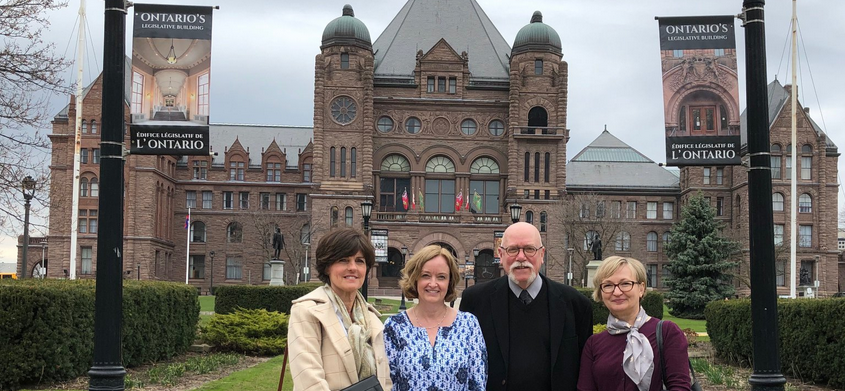 The We Love Burlington Executive met with the Burlington MPP, Jane McKenna at Queen’s Park. The Bill seeks to amend 13 different statutes that seriously impact municipalities and land use planning processes. It will change the collection of development charges with “soft charges” (i.e. those collected for community infrastructure such as libraries, community centres, arena, playgrounds or sports fields) no longer eligible for inclusion. The Bill will also seriously impact municipal heritage conservation. Bill 108 would also alter how development applications are reviewed by the City at the Local Planning Appeal Tribunal (LPAT).
It would effectively reinstate the former powers on the Ontario Municipal Board (OMB) whereby LPAT would determine the “best planning outcome” in development disputes and could once again overturn a municipal council’s planning decision. It would effectively reinstate de novo hearings.
WeLoveBurlington became concerned with the potential impacts of Bill 108 on Burlington and other municipalities when it saw the linkages to the provincial program downloading, capacity challenges and consultation/process deficiencies that are the true threats around the Ontario municipal government review.
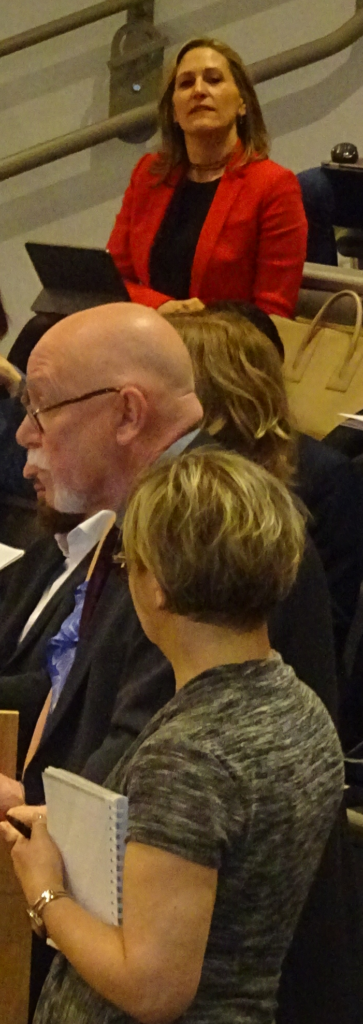 Mayor Meed Ward observing as the We Love Burlington delegation speaks to Provincial Review Advisors. Amalgamation was and is an effective rallying point but the issues with which we are most concerned are exemplified by Bill 108 – lack of adequate consultation with stakeholders and citizens around arbitrarily imposed changes, the quantum of dysfunctional change and unanticipated impacts imposed on municipal services and governance, the likely inability of an overloaded municipal system to accommodate the changes without higher taxes, reduced services and increased debt and, finally, the absence of a decisive and deciding voice for those most impacted by the changes – the citizens.
On June 1st, WeLoveBurlington responded to the extremely short deadline for comment on Bill 108. The contents of the letter follow.
May 31, 2019
The Honourable Doug Ford
The Honourable Christine Elliott, Deputy Premier
The Honourable Steve Clark, Minister of Municipal Affairs and Housing
Dear Premier Ford, Deputy Premier Elliott, Minister Clark:
Reference: 019-0016
Bill 108 – (Schedule 12) – the proposed More Homes, More Choice Act: Amendments to the Planning Act
Thank you for the opportunity to provide comments on the proposed Bill 108.
We are the WeLoveBurlington Advocacy Group. We are distinctly ‘grass roots’ and non-partisan. We advocate on a broad range of issues that affect the City of Burlington and its citizens.
At the outset, we would like to note several directions and tendencies of the current provincial government that have given us cause for ongoing concern and which we see unfortunately reflected in Bill 108.
First, a general rush to precipitous action with insufficient consultation with affected parties, interest groups and citizens generally. We understand that Bill 108 and its consequences are entirely within the powers and prerogatives of the provincial government. However, we firmly believe that appropriate and timely consultation with the electorate is a fundamental principle of the democratic process. Such has not occurred here.
Second, a tendency to download program funding and operational responsibilities with little consideration of their ultimate financial or operational impacts. Indeed, in many cases these potential affects are both unidentified and unclear resulting in a needlessly dynamic policy context and unfunded budgetary pressures. The result will predictably be reduced services, higher tax burdens and larger municipal debt.
Third, a tendency to disrupt and overload the existing framework of municipal services by imposing a quantum of change that is beyond the limited capacity of the municipality to accommodate. Bill 108 is simply the latest example of a series of provincially imposed changes to local municipal program delivery that were unplanned, unanticipated and threaten to render dysfunctional an already over-extended system.
In reviewing the proposed Bill we have multiple concerns but have limited our comments, given the very brief amount of time allowed for response and comment, to those that follow.
Threats to Bio-Diversity
The consequences of global heating and the need for preservation of bio-diversity are of the utmost importance to our province and our country in the 21st century. Unfortunately, instead of increasing the strength of our protections for these crucial needs, Schedule 5 of Bill 108 makes it easier for plants and wildlife habitat to be destroyed. If enacted as proposed, Bill 108 would lead to significant delays and uncertainty regarding listing of species at risk, provide for more exceptions and mechanisms for escaping the prohibitions, severely limit the government’s actions to protect and recover species at risk, and remove requirements for the Minister to consult with species experts. The amendments would also allow proponents to harm some species at risk in exchange for benefiting others (through landscape agreements) and create a mechanism where proponents can pay a regulatory charge in lieu of meeting conditions on a permit designed to protect and recover species or its habitat. The new term “pay to slay” that is finding traction with constituents is an apt if somewhat grotesque label.
Schedule 5 will accelerate the decline of species. This is not a trade-off voting constituents are willing to support. Schedule 5 should be eliminated from this Bill in its entirety.
Shorter Timelines for Review of Applications
Setting shorter timelines for the review of development applications directly impacts the ability of municipal planning staff to deal with the comprehensive nature of applications, consult with the public, or seek collaboration with applicants. Instead of allowing for the community and parties to work together, shortened timelines will increase adversity. These are impractical timelines for staff and Council for even the most simple, straightforward applications. The result will be even more appeals for non-decisions, thereby defeating the desire to increase housing faster.
Return to de novo Hearings
While the LPAT remains, it will no longer evaluate appeals based on compliance with official plans and consistency with provincial plans/policies. Bill 108 returns it to the more adversarial OMB process and, as such, a return to de novo hearings. This is very disappointing for residents and municipal governments, as it takes final planning decisions out of elected councils’ hands. Historically, the use of a de novo approach to appeals has resulted in drawn out hearings, lags in decisions and a backlog of cases. The return to this process has no positive effect to speed up housing development. This aspect of Bill 108 has been characterized as a return to the substance (if not the fact) of the former Ontario Municipal Review Board. We agree and consider it a fundamental flaw of the proposed legislation.
 The funding of public park space is expected to undergo a significant change, Parkland and Development Charges
A long-standing tenet of land use in Ontario, as established by the province and undertaken by municipalities, is for the building of complete communities – places where homes, jobs, schools, community services, parks and recreation facilities are easily accessible. As intensification and vertical housing become more prevalent, particularly in cities such as Burlington that are targeted for intensification, access becomes even more important.
For decades, the province has allowed municipalities to require parkland based on number of units being built, creating a direct relationship to the number of people living in a new development. If cities choose to keep a limited version of the parkland dedication by-law, they lose the ability to collect land or cash based on units built and are limited to require 5% of the land area of the new development. A 5% requirement on a small site being used for a high-rise development does not deliver a “park” space for residents that will contribute to livability in any manner. Our parks are critical pieces of infrastructure that not only help to alleviate the effects of global heating but also play a pivotal role in creating places where people actually want to live. Further, Bill 108 compels cities to spend 60% of the money they collect each year, thus making it harder for cities to save up funds for larger park projects and land purchases.
Not only does Bill 108 severely curtail the ability for cities to require developers to provide parkland onsite, it also removes the ability for those same cities to use development charges to collect money for parks and other soft infrastructure. The proposed new development charges amalgamate many of the tools cities have used for things such as affordable housing and turned them into either/or situations. These restrictions are exacerbated by a yet-to-be identified cap the government will announce at a later date.
No Answers to Affordable Housing
Bill 108 does not provide for any mechanisms to ensure that reduced development costs are passed through to future home buyers and renters.
In large part the development industry is permitted to build the product it most wants, wherever it desires and sell it at whatever price it chooses.
Allowing municipalities to utilize inclusionary zoning as one of a suite of tools to address and increase the supply and integration of affordable housing through private development represents a more effective manner with which to create affordable housing. By doing so, municipalities maintain the flexibility to utilize the tools most appropriate to the local context.
Bill 108 does not represent the government action voting constituents want from provincial leaders. The City of Burlington and municipalities like it across Ontario have well planned strategies for growth with specific areas identified for intensification and new development.
Reasonable timelines are in place to ensure professional review and assessment of development applications while providing constituents with a voice. The City of Burlington currently has in place an Interim Control Bylaw that has imposed a hiatus on development applications for one (potentially two) years. The bylaw was enacted as a necessary mechanism to cope with both the volume and the complexity of current development applications. This would override it and introduce virtual chaos into the evaluation and approval process.
We strongly urge you to pause Bill 108 in its entirety and work in tandem with the City of Burlington, the Halton Area Planning Partnership and like bodies across Ontario to attain plans and policies that reflect clarity, consideration and certainty in managing growth, delivering suitable development for our population and building infrastructure that works in favour of the people and the environment.
If the current government is truly “a government of the people” receiving its direction from ‘the people’, then it needs to both listen to their voice and permit them the time to articulate it.
Sincerely, We Love Burlington Executive

 By Gary Scobie By Gary Scobie
June 7th, 2019
BURLINGTON, ON
I am writing this to expose the absurdity of the Province’s growth centre density targets and how this absurdity is working against good municipal planning, against the livability of Ontario cities where targets apply, against the democratic right of citizens to control their own neighbourhood growth and for just one group – developers.
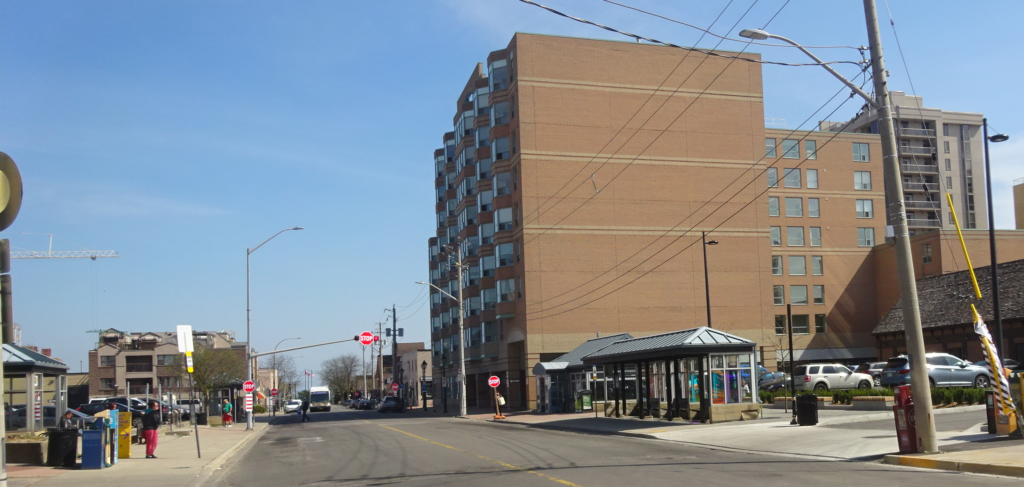 Mobility Hubs can be either full-fledged Gateway Mobility Hubs along GO Transit lines or Anchor Mobility Hubs where municipal transit stations occur. Is this really an Anchor hub? Henceforth when I refer to growth centres I mean official Urban Growth Centres assigned to municipalities by the Province and Mobility Hubs assigned either by the provincial Metrolinx organization or created by municipalities themselves. The Mobility Hubs can be either full-fledged Gateway Mobility Hubs along GO Transit lines or Anchor Mobility Hubs where municipal transit stations occur. Each has a density target assigned consisting of the number of People and Jobs (P&J’s) per hectare. Not all growth centres have the same areas or density target, but for simplicity I will use the largest area and the highest density target to describe the maximum effect, unless I use an actual growth centre that has been designated.
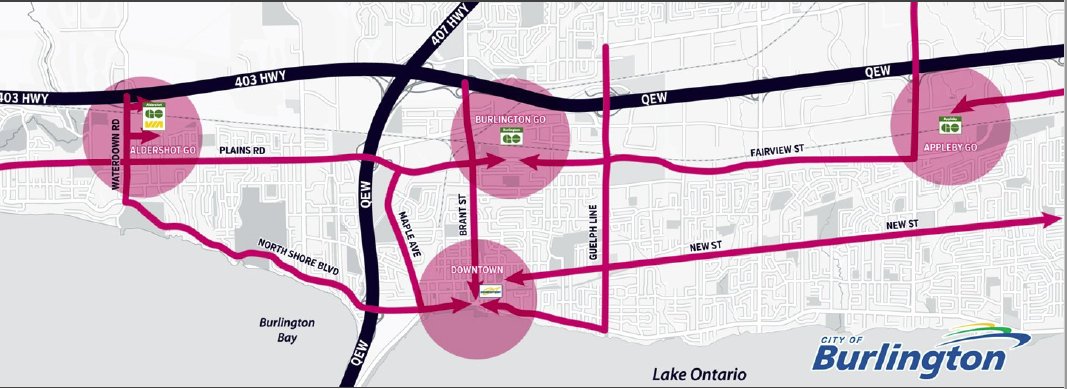 The thinking was to create four mobility hubs and allow significant growth. The studies needed to flesh this out have been put on hold, A theoretical growth centre is circular and can have up to an 800 metre radius. The area is calculated by the pi X r-squared formula we learned in school, where pi is 3.1416 to four decimals and r is the radius in metres. In this case the area could be up to 3.1416 X 800 X 800 = 2,010,624 square metres. A hectare is 10,000 square metres. So the maximum area of a theoretical growth centre is 2,010,624 / 10,000 = 201.0624 hectares. Let’s round this off to 200 hectares for simplicity.
The growth target for most growth centres is 200 P&J’s per hectare. So theoretically the largest growth centres could have up to 200 X 200 = 40,000 people and jobs within it. That in itself is quite a staggering number, when you consider that Burlington has a population today around 180,000 and if just one growth centre had a maximum area and no jobs, it would have to house 40,000 people in a relatively small area, about 22% of the current total Burlington population.
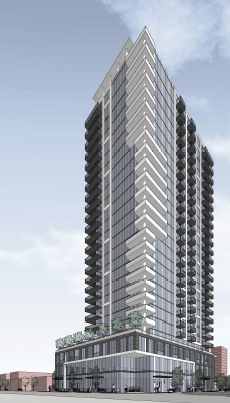 Going up opposite city hall – sales centre is operational. But let’s pause here and examine a real growth centre in Burlington, the Urban Growth Centre in the downtown. It is smaller than the circle I described as theoretical and it is shaped more like a upside down capital “T”, stretching up Brant street and adjacent streets and along Lakeshore Road. It is about half the size at 104.6 hectares. So its target is 104.6 X 200 = 20,920 P&J’s. Yes, that’s pretty dense. We were at 157 P&J’s in 2016, over 78% toward target. So we need to get to 200 P&J’s in this growth centre by 2031. At the pace of current approved and constructed or awaiting construction buildings, we will handily reach target well before 2031.
In actual fact, we will not need one more high rise building, beyond those approved, added in the Urban Growth Centre in the next 12 years. We could get to target with a mix of low and mid-rise new buildings. Even though overall Burlington population growth (again assigned by the Province without our consent) will have a new higher target assigned for 2041 compared to 2031, the growth centre density targets are unchanged for both dates. The new assigned population will be expected to be housed at the three GO Station Gateway Mobility Hubs that have been spec’d out for up to 69,000 people and jobs. So even with more assigned growth of population, it would seem that our downtown just might be able to survive and still be liveable at about 21,000 people and jobs by meeting its density target.
 Citizens are arguing for some limits on just how much development takes place in the downtown core. Interim Control Bylaw has halted any development for a year. But wait, there’s more! You see, the density target for growth centres of 200 P&J’s per hectare is a minimum target, as developers often point out. So what, you may say. We’ll make our minimum target and no municipality is being threatened by the Province with nasty repercussions if they don’t make theirs. But the Halton Home Builders Association is recommending density targets be increased once municipalities reach the minimum. So municipalities wouldn’t get rewarded for meeting the minimum target, they would get penalized by being forced to densify even further if this recommendation ever went through. Some reward.
Now here’s the real absurdity. The Province “encourages” municipalities to go beyond the minimum density target. OK, but how much beyond? Well, er, there is no “how much”. In the absence of a maximum density or a suggested maximum, there is no number given by the Province nor a hint of what it might be if there was one.
As an Applied Math grad, that can only mean one thing to me. The maximum is infinity. And most people know that means there is no maximum whatsoever. You can bet that the developers and their planners and lawyers, who are smart people by the way, certainly know this and love this gift from our Province. And they make good use of this phraseology of encouraging higher than minimum targets to lobby cities, the OMB and the LPAT that it is their civic duty to go, as Buzz Lightyear would say “to infinity and beyond”. It’s like a license to build ever higher, ever more high rises in growth centres “because the Province wants us to do it”.
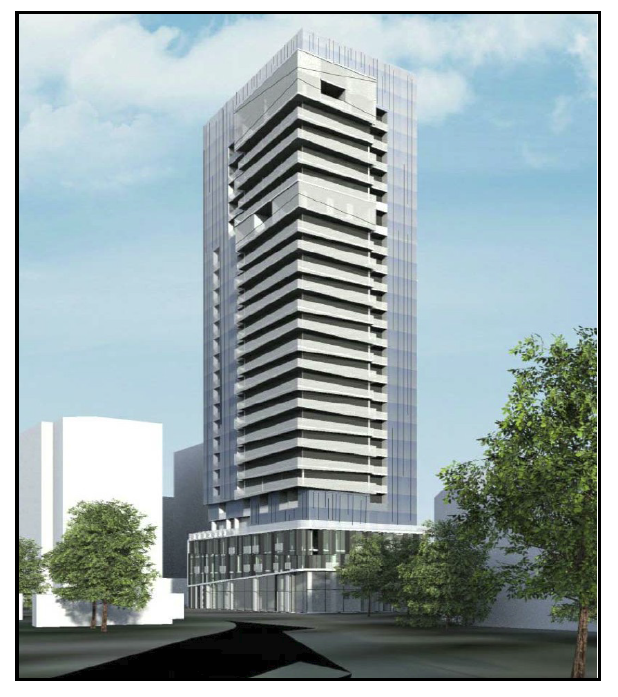 Approved – at 24 storeys – the city opposed the development – the OMB said they could. No hole in the ground yet – they are testing to determine just where the water table is. Would any Official Plan (OP) that doesn’t allow infinite growth in a growth centre therefore be not “in compliance” with the Provincial Policy Statement and the Provincial Growth Plan? So OP’s might be useless to stop this quest for infinite density? Good city planning might also be in danger, although the LPAT & OMB often refer to “good planning” as something they can identify and appreciate, especially when it comes from “experts” (most Planning Departments need not apply since only the Province decides who’s an expert, it seems). All these are worrisome issues for citizens who care about Burlington and support reasonable growth.
Confused? Don’t be. The latest suggestions for changes to the LPAT from the Province are to dismiss a municipality’s OP if it isn’t “good planning” and decide for them what “good planning” is and how many high rises should be allowed and how high these building should be in growth centres, so that we can reach toward infinity by 2031, by 2041, or by infinity I guess.
How many P&J’s should be stuffed into growth centres? An infinite number apparently. And developers are lining up to feast like they’ve never feasted before with high rises everywhere in growth centres, foisting these on unsuspecting municipalities.
In our capitalistic society, where money trumps all reason, municipalities and their citizens seem nearly powerless to stop this. Welcome to the absurd world of growth centre math and the greed that is satisfies.
Now I fully realize that the target is not infinity, but citizens must realize that the impetus from developers to build higher and higher is strong and steady and the Province with its proposed weakening of citizen input to the LPAT process and its proposed takeover of decisions on just how far we go with density and height (under its “good planning” auspice) are putting all cities in Southern Ontario at risk for destruction of the character of their downtowns, the increase of congestion in both people and vehicles and the lowering of livability standards.
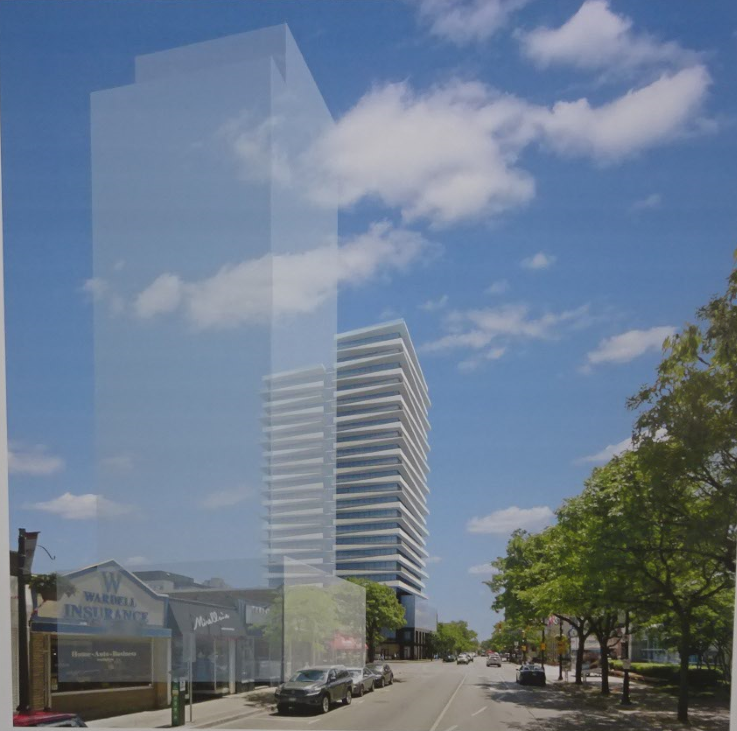 Looking south down Brant the light shaded building has been approved at 24 storeys, the building to the south of that has been ok’s at 17 – they are appealing to get 24 – same as the guy next door. Is this what Ontario city populations desire? Is this what Ontario citizens thought they were voting for a year ago? I don’t think so. Yes, there will be more people coming to cities and for many that will mean being housed in high rises around GO stations. Citizens realize and accept this. In Burlington we have room for this. So we’re not against growth, only growth in inappropriate places, like our downtown.
 Developer is asking for 24 storeys – same as the approved building to the east, What can we do? Contact the Mayor and your Councillor and support their efforts to stand against over-development of the downtown and also of the numerous plazas and strip malls that are or will face the same sort of pressure to infill at high density numbers far out of character with the surrounding neighbourhood. City governments and their planning departments must stand firm against what may seem an impervious and imponderable regime constructed by the latest version of our Provincial masters, who apparently think they know best how to manage our cities. Contact your MPP and let her know you want a made in Burlington development plan.
Citizens must attend local meetings on development hosted by the City and delegate at City Hall when Statutory Public Meetings are called. Let the Province know that we care about our city and our elected officials know better how to manage growth than the Province does.
Only the sky is the limit to developers. We need to lower that limit.
 Gary Scobie is a frequent commentator on how Burlington can grow – he advocates for responsible and thoroughly thought through growth. Gary Scobie is a frequent commentator on how Burlington can grow – he advocates for responsible and thoroughly thought through growth.

 By Pepper Parr By Pepper Parr
June 7th, 2019
BURLINGTON, ON
Reality has hit the city’s planning department.
They have put the Mobility Hub Study on hold while they deal with the re-examination of the adopted Official Plan and the Interim Control Bylaw, passed on March 25, 2019.
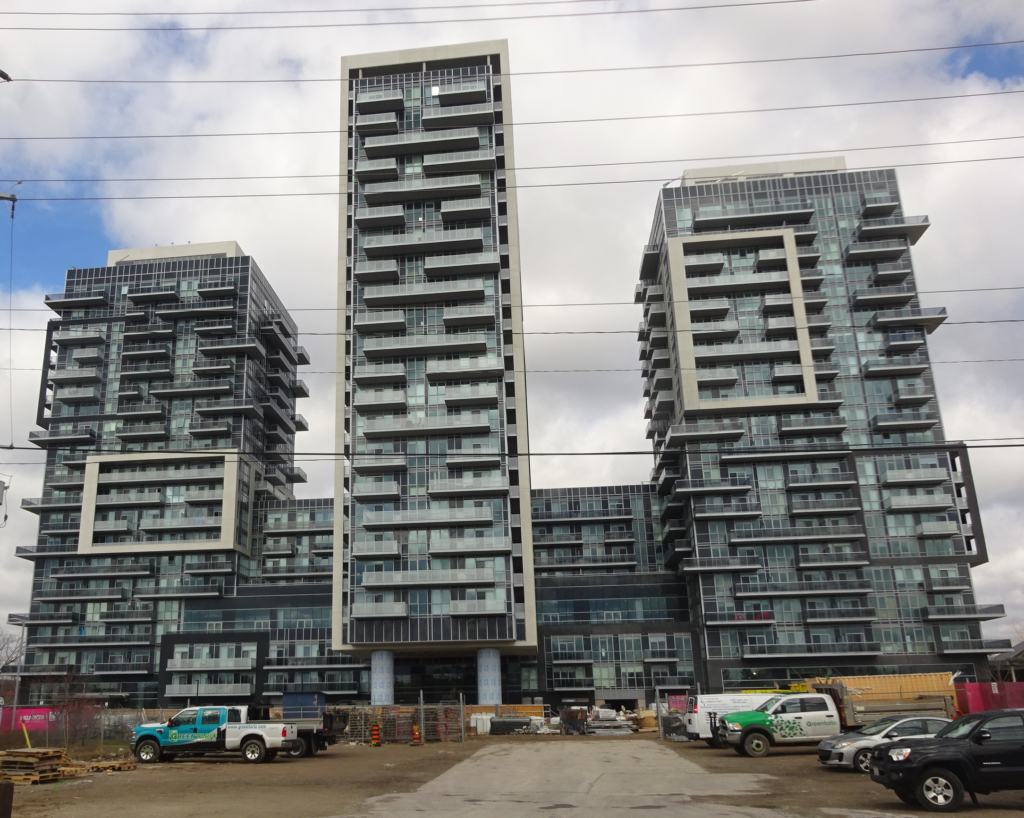 The first three of a five tower project right beside the Burlington GO train tracks has sold well. It was the right kind of development in the right location. Work on the Mobility Hubs, including the development of the Downtown Mobility Hub Area Specific Plan (secondary plan), has been taken out of the day to day operations.
What will the impact of that decision be? There are so many balls in the air that it is difficult to fully comprehend what can impact what – loads of room here for unintended consequences.
Kudos for the Planners for making a tough call.
The focus on the GO stations as the location for growth was a sound decision – the trick is to get it right the first time.

 By Pepper Parr By Pepper Parr
May 27th, 2019
BURLINGTON, ON
 Marianne Meed Ward at the State of the City address to the Chamber of Commerce. One of the promises Mayor Marianne Meed Ward made to the Chamber of Commerce when she delivered her State of the City address to them was to improve the way business was done in the city.
She created a Red Carpet Red Tape initiative that was going out into the commercial sector to ask questions and to listen. She brought Kelvin Galbraith, the Councillor with the best small business experience in as her co-chair and they have been listening.
For reasons known only to the Mayor the listening sessions have been closed to media – all we have to work with are the statements she releases. There is a lot of information in them.
The first session took place at the Waterfront Hotel where issues that were to become a theme as the Red Carpet Red Tape (RCRT) wagon rolled along.
Parking, getting paperwork and approvals through city hall and finding talent that could be employed and able to find affordable accommodation were mentioned at every session.
We have lifted portions of the reports the Mayor released and put them within quotation marks.
Small business types wanted “Access to qualified young labour. Factors that play a significant role in that challenge are a) the high price of living in Burlington and b) the difficulty in commuting here by anything other than a personal automobile, which many don’t have.
“Trying to recruit skilled employees from surrounding trade schools/colleges/universities is difficult when they find out how expensive starter townhomes or condos are here. With the often bus-train-bus experience most would have to partake in should they decide to commute from a neighboring community with potentially more affordable real estate options, the length of time of the commute becomes too prohibitive. Bottom line: more needs to be done to allow young people to live and/or work here, whether it’s through more affordable housing options or better/faster transit options.
 Is an $800 Engineering report necessary for signageÉ “Red Tape. Many examples were given of challenges before a business could open, and the labyrinth of approvals and expenses that came along the way. Reference was made to needing engineering approvals on storefront signage (a reasonable request to ensure they’re safe and won’t fall on anyone) but there was a lack of understanding of whether the $800 engineering fee was reasonable, or whether more could be done to educate new business owners about alternative options that may be more affordable. Other examples were given about starting down one path of approval, only to be told later in the process that additional items were needed and additional expenses would have to be incurred that they had not budgeted for.
“Answers given by City Staff were referenced as sometimes being inconsistent with one another, leading to confusion. Overall, many spoke about a lack of support through the process. Those who had been around for 20+ years made reference to having strong and experienced mentors and using their own hard work and ability to pull in experts to advise them on things from accounting to networking and beyond.
 BDBA General Manager Brian Dean working a crown during a downtown festive event,. “Some attendees had no idea if they belonged to their local BIA (or whether they even could), and most did not know about support that could be provided to them through partner organizations like the BEDC. Many wished they could give advice to new businesses setting up shop and better inform them of whether the location they are choosing is appropriate for their business model to help them avoid failure, and whether landlords and real estate agents can better help facilitate that evaluation for likelier long-term success.
“Bottom line:” posited the Mayor, “Can a smarter welcome package be created for those exploring starting a new small business in Burlington – one that outlines all the steps needed before opening, the demographics of different neighborhoods, and clearly directs people to the other resources available to help them get there? Can our staff be well-trained to provide a supportive and welcoming “red carpet” experience when new businesses reach out to start the process?
 Parking meters are a challenge at several levels. “Parking. While this is more of an issue for small business owners south of the QEW, such as in Aldershot or Downtown Burlington, it is a known challenge and source of frustration. When discussing Free Parking in December…business owners referenced abuse by people who already have parking passes elsewhere like their condos (but find street parking more convenient), and those who are employees of local businesses and drive to work that month since they can now get free parking. Neither option helps paying customers find additional spots.
It was generally felt that there were too many confusing rules around parking in general (paid during the day but not after 6, but free in December, but still no parking anywhere for longer than 3 hours although there are some lots with exceptions to that, etc…). Bottom line: we need to think about the initiatives we are implementing around parking and whether they are supporting the goal they were intended to support.
The large manufacturers had their own issues.
The Permit process – flaws and delays
Dealing with the MTO – lack of accountability to timelines, unwilling to conduct site visits
City is too slow to react
City staff have a lack of knowledge behind the scenes/of private sector and are unresponsive
Staff are inconsistent in their application of policy
Fees are inconsistent
Turnover of City staff
Sense of confrontation with City staff – rational conversation is difficult
Lack of common sense and practicality in processes
Commercial/employment zoning needs
Regional transit connectivity and transportation/traffic overall
Lack of land availability / larger space for manufacturing
Sign bylaws are too restrictive
Access to high tech talent / post-secondary / new fields & areas of study
Site visits are needed to understand practical issues
Tough finding the right department at the City
Incremental feedback on multiple submissions
Need clear timelines / business timelines
Ineffective communications
Lack of incentives if not manufacturing
Skilled and non-skilled labour/talent
There were issues that were positive; The Mayor referred to them as “issues that were already working from their point of view.
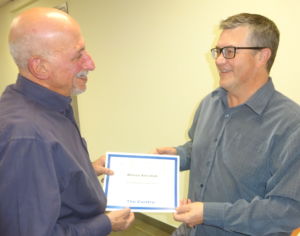 Recent immigrant, on the left, receiving a certificate after completing a course at The Centre. New council = progressive thinking
The Red Tape Red Carpet Task Force – appreciate the City is listening and willing to change
BEDC support, networking events and TechPlace
Employee retention and recruitment
Recent immigrants in the area provide a great talent pool
Success in exporting / export funding was helpful (got cut thought)
Location: close to highways, the border, and Go train
Innovation through partnerships
Growth of manufacturing locally
Rotational Engineer program uses fresh grads to fill roles
Product development support funding (SRED, IRAP)
Access to a huge market next door (Toronto)
Engineering staff at the City of Burlington are constant, fair, good to deal with, consistent
The Mayor added that the “wealth of knowledge and experience in the room put forward the following ideas about what can change and improve:
Work hard to create a customer service culture at City Hall. Start at the top and trickle down. Help everyone feel good at the end of the day for what they did and how they did it.
Change how work is assigned: Rather than having work assigned to whoever is next available, have the same person allocated to all permits for the same building so that the familiarity is there to increase speed and customer service rather than have so many different people involved each time and forcing them to start at square one and get up to speed.
Advocate and influence with other government and regulatory agencies.
Site plan vs. survey education – field trips and training
Include copyright protection (not here now)
Ombudsman backed by Council
Better performance management of City staff with KPIs attached / measurements
Consider CRM/Software solutions for better digitization/automation of processes as well as tracking
Electronic file transfers of documents submitted
Status on reports on file in less than 3-4 weeks / Customer Status reports conducted by Staff
Lunch & Learns for Developers
Exception approvals at the counter
Staff to ask the question: how can we make this work?
New City staff should have to have spent time in the industry first (externally)
 Much of the longer term development will be located at the mobility hubs. Leverage development around Go stations
List of issues that are black/white – clear & automatic (ex: building code)
Personalization of website – “what are you here for today”
Self-serve options
Overall management / admin/ project management for applications
Business concierge support
More mixed-use service available without getting in car
Better marketing and promotion of Burlington to businesses
Need tax credit advocacy with Minister of Finance
Review incentive programs to be more accessible
Incentives to hire new grads
 Several of the courses given at The Centre are fully booked months in advance – the students usually know where they are going to be working before they graduate. Need a tech school in Halton (post-secondary)
Ontario apprenticeship: training and tax credit (needs new process released)
Increase limits on “Now Hiring” portable signs
More affordable housing (for employees)
Foreign worker depository
All day Go train (24 hours)
Transparency on timelines / status updates
Be willing to refund processing fees if deadlines aren’t met by City
“Overall”, said the Mayor, “the session on Monday provided a forum for this group of leaders to directly communicate with myself, other City leaders, and each other, helping ensure our businesses feel heard, valued and supported as critical parts of Burlington’s economic health and well-being.
Next up on the focus group list was a session with City staff and partnership organizations:
Mayor Meed Ward explained “the room was asked to identify the most common issues they hear from business owners and there was a lot of commonality: zoning, permits, signs and approvals were all identified as taking too long, requiring too many stakeholders’ involvement, and being challenging to navigate (especially for first-timers).
“Everyone agreed that working towards more of a “One-Stop Shop” would provide a better customer service experience and staffing that shop with subject matter experts who can guide people through the process, set realistic expectations, and provide all the information up front would be ideal. Having people to triage applications so they require fewer revisions would also be helpful in reducing timelines and workload on both sides of the table.
“The room noted that more could be done to get information online and searchable, letting business owners self-serve and self-educate when possible, and do things after hours when appropriate. Marketing, education, and information sharing was a common theme, whether through campaigns to educate prospective business owners on avoiding common pitfalls in the application process, or having monthly open-house sessions where business owners can meet with experts like those in the focus group room to get free advice to help them along the way.
“Looking at technology systems and platforms that enable barcoding/tracking of applications would improve speed and accountability in everyone’s view, and exploring ones that dovetail with those of partner organizations would be helpful as well.”
What was both surprising and disturbing was that the people making these comments were the very people hired to run the city. The Mayor reported that the attendees at this one included the following (the Gazette has added some comment on several):
“Ron Steiginga (by the way a very smart guy who has served the city well) “25+ years in real estate management with the City of Burlington has let him get to know most of the developers and builders in town, build relationships, and stay aware of what is available for sale. He is involved with fees (such as park dedication fees), and the purchase of parks, fire hall sites – sees his role as keeping stakeholders aware and informed of those issues and availabilities.”
“Rosalind Minaji has been in planning and development for 30 years, and a big part of her role is to help walk people through the application process, as well as ensure the city has sufficient and identified employment areas, as well as affordable housing.
 Director of Finance Joan Ford does a great job of providing the data ad her department does a good job of collecting the taxes as well. It’s the spending side that is causing the long term financial stress. Ms Ford doesn’t do the spending. “Joan Ford (who runs the best department in the city) has been in finance for 30 years and sees her role as ensuring fees and taxes for business owners are collected in a fair and equitable way, and being transparent to businesses on these items.
“Mary Lou Tanner has been with the City for three years and in her Deputy City Manager role for 18 months. She sees her role as creating a culture of customer service for business owners who come to the City with questions and looking for guidance with what can often feel like an overwhelming or complicated journey. She wants to ensure people feel welcome, get the answers they need, and help make processes easier and better understood.” Tanner created the Grow Bold initiative that Mayor Meed Ward had council scrap once she took office.
“Sue Connor is two years into her role, with 30 years overall in the transit industry. She knows she needs to help move employees around so that businesses have access to the people they need to make their business run.” Connor brings an incredible reputation to the task of creating a transit service that people will use – all she needs is the support of council and the funds to make it happen. If she manages to do for Burlington what she did for Brampton we will be a much different city.
“From the BEDC, Anita Cassidy’s focus is in helping create a competitive advantage here in Burlington so that businesses want to locate here, helping them find talent or space, as well as advocating for what businesses need with partner organizations like the MTO or the Region. Cassidy is waiting to be moved from acting to full bore Executive Director.
John Davidson has been at Halton Region for 13 years and mentioned the Small Business Centre that is run out of there as a good resource for business owners starting out. He sees his role as ensuring businesses don’t get stalled in their approvals/permits journey and working behind the scenes with partners like the City of Burlington and others to remove obstacles.
“Tim Commisso, in the industry for 35 years now, sees one of his priorities as helping implement more of a 1:1 personal touch for smaller businesses who don’t necessarily have the experts and resources of larger firms and developers to help navigate the system. He also expressed interest in seeking out technology that makes the process easier and more trackable, and ensuring city staff have the skills and customer service attitude to make these experiences better for businesses.” Commisso knows the Burlington file – he served as part of senior management before he was appointed city manager for Thunder Bay. He is keeping the city manager seat warm until council makes a permanent appointment – expected sometime in July.
“Brian Dean has been at the Burlington Downtown Business Association for 18 years now and sees his role as retaining and attracting businesses to this area of our City. He works to help acclimatize new businesses, give them market data to help with their business planning, and keep them engaged with their community.” Dean must have been stunned when he heard that some business people had not heard of his BIA.
 “Keith Hoey, outgoing President of the Burlington Chamber of Commerce (15 years now), focuses on: a) connecting people through networking and events; b) educating businesses on things like managing their books or understanding government decisions that will impact them; c) advocating with all levels of government on behalf of business owners; and d) providing discounts and savings to help businesses save money.” A Prince who has earned retirement and will be missed – those shoes are going to be hard to fill. “Keith Hoey, outgoing President of the Burlington Chamber of Commerce (15 years now), focuses on: a) connecting people through networking and events; b) educating businesses on things like managing their books or understanding government decisions that will impact them; c) advocating with all levels of government on behalf of business owners; and d) providing discounts and savings to help businesses save money.” A Prince who has earned retirement and will be missed – those shoes are going to be hard to fill.
 Allan Magi, on the left, brings a capacity to listen and a collaborative manner to the work he does for the city. “Allan Magi, 27 years into his tenure, oversees the building of parks, roads, and other infrastructure that needs to be in place to support the businesses in our city. He helps oversee development charges, and advocates with partner agencies to streamline and find common ground to help move things along.
Nick Anastasopoulos has been with the City for 3 years, and 20+ years in the industry. He sees his role as helping get businesses “in the ground” and up and running. He looks for efficiencies and overlap to help streamline processes, and is focused on finding ways to connect partner agencies to work faster together for businesses.
Gerry Smallegange at Hydro gets involved with new businesses and expansions as many businesses have unique or additional hydro needs when they relocate/start up here in Burlington. He sees his role as finding ways to partner with businesses before they sign leases or purchase property to advise them on what is possible and consider meetings or site visits to better equip businesses with the information they need before they sign on the dotted line, so they can avoid zoning or other problems down the road.
“Kelvin Galbraith is new to his role as Councillor but has been a small business owner for 21 years in Aldershot, and is a member of the Aldershot BIA. He sees his role as similar to the Mayor’s: see the issues and help solve the problems.
 Heather MacDonald, Director of Planning has the most difficult job – a department that has been flooded with work during a time when both the regulatory and political environment were difficult (impossible?) to cope with. “Heather MacDonald is newer to the City of Burlington in her role, but has many years of experience including years at Metrolinx, the City of Brampton and the City of Mississauga. She and her team (including Rosalind and Nick) are tasked with ensuring we have buildings and businesses that are safe and of high quality, and helping people through the development process. She wants to impact the level of education and communication outward to business owners to avoid people feeling surprised down the line and ensure they have the right information – and all of it – as early in the process as possible.”
It is difficult to read the narrative on those who took part in the meeting with the complaints that were heard from the commercial sector. There is a disconnect in there somewhere.
When Meed Ward announced the RCRT initiative she said: “My goal is to find a way to help our city grow in the right way and in the right places, and to partner with my colleagues at City Hall, with residents, and with our development community to make that happen.”
The Mayor then met with the developers, using the Tech Place facility as the venue. She was probably not surprised at what she heard:
 Is there a vision? Is it in the minds of city council or in the approach staff take to problem solving.? Or does the public have a vision no one else shares? The Permit process – flaws and delays
Ability to attain SPAs in a reasonable time
Dealing with the MTO – lack of accountability to timelines, lots of delays
Delays with Halton Conservation
Conflict between the different levels of government
Business mindset is lacking
Lack of accountability with the City
Too many agencies involved
Staff act like they’re afraid of losing their jobs
No incentives to reduce operational friction
Hydro
Inconsistent bylaw/zoning interpretation/zoning uncertainty
Lack of vision
Lack of control over other agencies / influence
Affordability of projects becoming unrealistic: land, construction, time all push up costs
No “leader” to manage applications
Lack of KPIs for city staff (perceived or otherwise)
 Provincial policies trump everything – and they keep being changed making it difficult to do long term planning. Provincial policies are shifting / rethinking
Lack of staff knowledge in understanding market forces
Lack of respect for landowner rights
Too in the weeds – focus on important issues
Lack of common sense being applied
Opinions can depend on mood of person who is assessing the application
Building envelopes
No severance / Niagara Escarpment Commission
Environmentals on particular corridors
All the time delays cost money
Political agendas – development applications treated politically instead of on their own merit
Time associated with the severance process (took 2 years)
Zoning inflexibility (ex: Seniors Long Term Care facility)
Timing associated with obtaining a zoning verification letter – used to be 10 days now over 5 weeks
City staff raising issues that do not apply to the application in question
Limited incentives available for developers to build sustainably, and integrate sustainable design features
Public transparency re: cost recovery/recovery funding
Compare to Brampton, where 100 units got approval in less than a year – fast process, open to discussions, and Mayor/Council wanted things to happen
Perception that plants and animals have more rights than people
Hard to get calls returned from City Hall (all departments)
Outdated city standards (ex: Parks)
Lack of downtown parking for offices, bars, restaurants and retail
Transit dead spots
After listening to the complaints and concerns the Mayor did a smooth political pivot and said: “While it took a few minutes to switch gears and focus on the positives, there are certainly reasons everyone in the room is still doing business in Burlington and we wanted to ensure we clearly understood what those are and then she listed them:
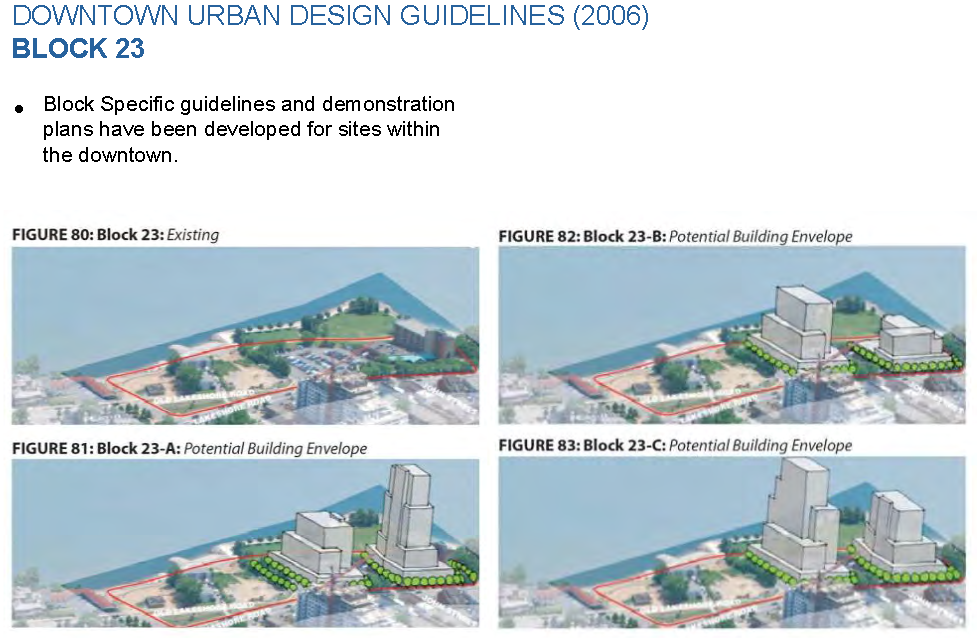 Developers want clear instructions – and will do everything they can to find a way to make those directions work to their benefit; which is exactly what we do with our tax returns. BEDC as a facilitator, expeditor and supporter
Great fast-track process for building permits
Experienced city staff are good to deal with
Online process that shows if a building permit is closed
Mayor seems very on board
Facilitation at this event was great – Interim City Manager was great facilitator at the table
Professional people to deal with
Sustainable design guidelines
Ability to start work early to help shorten delivery sometimes
Burlington building process is good
Councillor was helpful overriding bad staff decisions
Building department closing out an old permit +
We win most if not all appeals to OMB/LPAT
Development application website is good
Community safety – businesses with shifts / evening hours are less worried for their staff getting to/from work
Burlington’s culture, family-orientedness & energy draws people here to live and work
Access to talent, amenities and housing (high tech talent is easier than other segments though because of housing costs).
Developers do business in Burlington because it is a great market – they can build almost anything and sell it. They have chosen to focus on the high end of the market and for the most part are doing very well.
The Mayor took what she could from the meeting and closed by saying: “We finished the day by leveraging the knowledge and experience in the room to come up with solutions, ideas and changes that the City can spearhead to make things better:
 The key word is service – does city hall know how to deliver it? Will the new city manager make that a key deliverable ?  Private sector experience makes for better public sector employees. Support a culture of service and efficiency by ensuring staff have clear KPIs and they are part of their performance reviews
Incentives for hitting KPIs and going above and beyond
Business/file liaison to track, communicate, and shepherd a file to completion in a reasonable time
Leadership needs to stand behind file planner
Encourage staff to learn more as things change to drive subject matter expertise (regulations, etc.)
Leverage better technology to streamline and automate / CRM system / Self-Serve
Customer service training / commitment to customer service
Hire more people if short-staffing is impacting speed of turnaround
Cut the timelines to match the Municipal Act
Apply a stronger sustainability lens and offer incentives
Allow multiple levels of approval to run concurrently
Seniors housing/land zoning strategy
Business advisory board
BEDC needs more influence
More advocacy/upward pressures necessary to other levels of government
Stand firm on the position of what is good for Burlington – don’t sit on hands with other agencies
Be collaborative vs combative
Site visits at properties to understand context and better apply common sense
Create more “fast track” and “premium” services – willing to pay for speed
Do more to educate the public about the benefits of growth to help those inherently resistant to change to see the positives
Make it a priority or essential that new hires in these departments have spent at least some time in the private sector on the other side of the table to provide better perspective and understanding
Next round of comments shouldn’t go back to bottom of the pile
Be ok with weighting the value of certain projects in their worth to the community (jobs for example) and be willing to prioritize those in terms of speed and attention – not every project is equal
Apply Artificial Intelligence / automated processes to remove personal opinion from the process
Shorten time frames for turnarounds of minor revisions
Fees should be payable on approval not all up front (or reimbursed when deadlines are missed)
Empower staff with more decision-making power to apply common sense
Remove height restrictions
Educate the public on good planning practices
Be more consistent – don’t change policies when Councillors change
Leverage tech being used in other municipalities (ex: Mississauga)
Focus group with staff: what are THEIR challenges to moving quickly & how can we help
Provide more info on the steps that happen in the process & why it takes so long. What is happening each day over the course of all those months (and sometimes years)?
Quick morning meeting/daily scrum (15 min) each day by team leaders to set goals with staff: what will you get off your desk today and move forward? Then hold people accountable and recognize good performance. Ask the question “What will it take to get this approved today?”
More of a culture of recognition for making things happen. Celebrate those staff.
Interesting that the city spends something in the order of $7 million a year on cultural matters: Performing Arts Centre, Art Gallery and the Museum but there wasn’t a mention of how big a driver this sector is to a local economy.
The Red Carpet is a brave initiative – one hopes that even a small percentage of what got put on the table will actually get done. Let us leave it at that.
Related article:
Public service is noble work

 By Pepper Parr By Pepper Parr
May 15th, 2019
BURLINGTON, ON
Two things struck me during the Monday and Tuesday Standing Committee meetings.
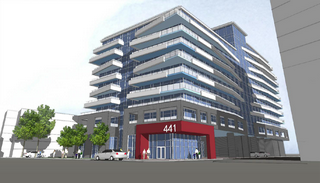 The first was during the Statutory meeting on the development proposal for 411 Maple Avenue where the operator of a long term care nursing home wants to sell the property to a developer and use the proceeds from that sale to build a new long term care retirement home in the Alton community. The first was during the Statutory meeting on the development proposal for 411 Maple Avenue where the operator of a long term care nursing home wants to sell the property to a developer and use the proceeds from that sale to build a new long term care retirement home in the Alton community.
The proposed development is inside the Urban Growth Boundary, which is currently under an Interim Control Bylaw that has stopped things cold.
Much of the discussion during the lengthy meeting was about the heights involved. What started out as a 22 + storey building, got whittled down twice to the now 11 storey development.
The operators of the long term care retirement home were hoping that they would get an exemption from the interim control bylaw.
That didn’t happen.
 Heather MacDonald – City Planner Here is what did happen which was interesting. Kelvin Galbraith asked Heather MacDonald, the Planning Director if the practice in the new official Plan would be consistent in its use of measurements.
The Director wasn’t able to say – absolutely.
We have heard complaints from a number of people about the way the height of a structure is defined. Planners tend to use the number of storeys – but a storey isn’t a unit of measure – it is used to describe some space.
 Ward 1 Councilor Kelvin Galbraith wanted to know what unit of measure was being used to determine the height of a development. Galbraith wanted to see metric measures used and he appeared to want the actual height of the building to the top of the very top floor. He appeared to want to know just how many metres in the air the building was going to rise.
On occasions a developer will say it will be 11 storeys with an amenity area at the top. That amenity space is an additional number of metres of height.
One would have thought the Planning Director would have taken the opportunity to say that there would be data that would be clear.
A missed opportunity. Hopefully we might see a council member pick up on the need for clarification and get a staff direction in place setting out how developments will be described when it come to their height.
Burlingtonians are a little sensitive about height these days.
The second thing that struck me was what we spend on the culture-entertainment sector. Some whoppers in those numbers – that is covered in a separate story.

 By Pepper Parr By Pepper Parr
May 10th, 2019
BURLINGTON, ON
Oh to have been a fly on the wall.
There she was at the front of the room asking a group of developers and real estate types – what can we do for you?
Had Jeff Paikin been in the room the Mayor would have gotten an ear full. In a recent communication with us he said:
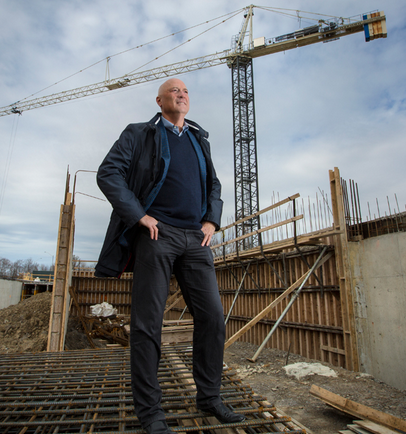 Jeff Paikin – New Horizons Development. “Moved to Burlington permanently for our offices just in time to be subject to a council that shuts down our business and a mayor who twice uses unauthorized videos of our site to stand on her soap box and pump up over-intensification even when it doesn’t exist. Nice warm welcoming feeling for a company that pays and has generated hundreds of thousands of tax dollars annually.”
We wonder how Jeff really feels.
Mayor Marianne Meed Ward was doing another part of her Red Tape Red Carpet initiative to learn how the city could be what Premier Ford has already declared we are: – and that is Open for Business.
The focus group Meed ward was meeting with was made up of a full-house of over 40 leaders from the development and real estate industry. It appears that the audience was made up of people who volunteered to attend and perhaps a few that were asked to take part.
In her newsletter on what has become known as the RTRC initiative Meed Ward said:
 Development in the City of Burlington is a very hot issue: Mayor Marianne Meed Ward “As everyone is well aware, development in the City of Burlington is a very hot issue, and was one of the most commonly discussed during last fall’s election campaign.
“My goal is to find a way to help our city grow in the right way and in the right places, and to partner with my colleagues at City Hall, with residents, and with our development community to make that happen.
“With that said, the Red Tape Red Carpet Task Force initiative is not just about development. It’s about helping all of Burlington’s businesses thrive. Developers and real estate professionals are just two industries of many in our city, but they overlap with those of businesses that are growing, relocating, or starting out here. Their struggles become the struggles of other businesses too.
“At the same time, developers are a business like any other, and while they face challenges around permits and approvals, they also have to deal with access to talent, adequate transit, employee parking, and beyond.
“The focus group was an important step in better understanding the top issues facing this group, and I appreciated how many leaders from these industries showed up to participate in this journey.
“While the City of Burlington’s current Interim Control Bylaw was top of mind for many in the room, we know that geographically that only applies to 1% of our land in Burlington. Furthermore, we know things weren’t perfect before that was put in place, so we focused on the challenges that already existed and have long-term impact.
“What we heard from this audience was the following challenges – again, many of which were commonly heard at other groups we’ve met with over the past 2 months (common themes from yesterday’s session are highlighted in bold):
The Permit process – flaws and delays
Ability to attain SPAs in a reasonable time
Dealing with the MTO – lack of accountability to timelines, lots of delays
Delays with Halton Conservation
Conflict between the different levels of government
Business mindset is lacking
Lack of accountability with the City
Too many agencies involved
Staff act like they’re afraid of losing their jobs
No incentives to reduce operational friction
Hydro
Inconsistent bylaw/zoning interpretation/zoning uncertainty
Lack of vision
Lack of control over other agencies / influence
Affordability of projects becoming unrealistic: land, construction, time all push up costs
No “leader” to manage applications
Lack of KPIs for city staff (perceived or otherwise)
Provincial policies are shifting / rethinking
Lack of staff knowledge in understanding market forces
Lack of respect for landowner rights
Too in the weeds – focus on important issues
Lack of common sense being applied
Opinions can depend on mood of person who is assessing the application
Building envelopes
No severance / Niagara Escarpment Commission
Environmentals on particular corridors
All the time delays cost money
Political agendas – development applications treated politically instead of on their own merit
Time associated with the severance process (took 2 years)
Zoning inflexibility (ex: Seniors Long Term Care facility)
Timing associated with obtaining a zoning verification letter – used to be 10 days now over 5 weeks
City staff raising issues that do not apply to the application in question
Limited incentives available for developers to build sustainably, and integrate sustainable design features
Public transparency re: cost recovery/recovery funding
Compare to Brampton, where 100 units got approval in less than a year – fast process, open to discussions, and Mayor/Council wanted things to happen
Perception that plants and animals have more rights than people
Hard to get calls returned from City Hall (all departments)
Outdated city standards (ex: Parks)
Lack of downtown parking for offices, bars, restaurants and retail
Transit dead spots
“While it took a few minutes to switch gears and focus on the positives, there are certainly reasons everyone in the room is still doing business in Burlington and we wanted to ensure we clearly understood what those are:
BEDC as a facilitator, expeditor and supporter
Great fast-track process for building permits
Experienced city staff are good to deal with
Online process that shows if a building permit is closed
Mayor seems very on board
Facilitation at this event was great – Interim City Manager was great facilitator at the table
Professional people to deal with
Sustainable design guidelines
Ability to start work early to help shorten delivery sometimes
“None”
Burlington building process is good
Councillor was helpful overriding bad staff decisions
Building department closing out an old permit +
We win most if not all appeals to OMB/LPAT
Development application website is good
Community safety – businesses with shifts / evening hours are less worried for their staff getting to/from work
Burlington’s culture, family-orientedness & energy draws people here to live and work
Access to talent, amenities and housing (high tech talent is easier than other segments though because of housing costs)
“Again, we finished the day by leveraging the knowledge and experience in the room to come up with solutions, ideas and changes that the City can spearhead to make things better:
Some of the comments Meed Ward highlights are:
Support a culture of service and efficiency by ensuring staff have clear KPIs and they are part of their performance reviews
Incentives for hitting KPIs and going above and beyond
Business/file liaison to track, communicate, and shepherd a file to completion in a reasonable time
Leadership needs to stand behind file planner
Encourage staff to learn more as things change to drive subject matter expertise (regulations, etc.)
Leverage better technology to streamline and automate / CRM system / Self-Serve
Customer service training / commitment to customer service
Hire more people if short-staffing is impacting speed of turnaround
Cut the timelines to match the Municipal Act
Apply a stronger sustainability lens and offer incentives
Allow multiple levels of approval to run concurrently
Seniors housing/land zoning strategy
Business advisory board
BEDC needs more influence
More advocacy/upward pressures necessary to other levels of government
Stand firm on the position of what is good for Burlington – don’t sit on hands with other agencies
Be collaborative vs combative
Site visits at properties to understand context and better apply common sense
Create more “fast track” and “premium” services – willing to pay for speed
Do more to educate the public about the benefits of growth to help those inherently resistant to change to see the positives
Make it a priority or essential that new hires in these departments have spent at least some time in the private sector on the other side of the table to provide better perspective and understanding
Next round of comments shouldn’t go back to bottom of the pile
Be ok with weighting the value of certain projects in their worth to the community (jobs for example) and be willing to prioritize those in terms of speed and attention – not every project is equal
Apply Artificial Intelligence / automated processes to remove personal opinion from the process
Shorten time frames for turnarounds of minor revisions
Fees should be payable on approval not all up front (or reimbursed when deadlines are missed)
Empower staff with more decision-making power to apply common sense
Remove height restrictions
Educate the public on good planning practices
Be more consistent – don’t change policies when Councillors change
Leverage tech being used in other municipalities (ex: Mississauga)
Focus group with staff: what are THEIR challenges to moving quickly & how can we help
Provide more info on the steps that happen in the process & why it takes so long. What is happening each day over the course of all those months (and sometimes years)?
Quick morning meeting/daily scrum (15 min) each day by team leaders to set goals with staff: what will you get off your desk today and move forward? Then hold people accountable and recognize good performance. Ask the question “What will it take to get this approved today?”
More of a culture of recognition for making things happen. Celebrate those staff.
 The next focus group will include several contributors from the rural business ecosystem who sit on the newly formed Agriculture and Rural Affairs Committee with the City of Burlington. The next focus group will include several contributors from the rural business ecosystem who sit on the newly formed Agriculture and Rural Affairs Committee with the City of Burlington.
The next step is to take the learnings and information back to the Committee at their next meeting later this month.
Meed Ward has moved with considerable dispatch on this initiative. What is disturbing is that she has ensured there is no media in the room. Why not?

 By Staff By Staff
May 3rd, 2019
BURLINGTON, ON
The policy announcement made yesterday by the provincial government covered a lot of bases.
It said that: “The Greater Golden Horseshoe is the economic engine of our province, generating more than 25% of Canada’s Gross Domestic Product. Right now, approximately 9.2 million people, or 25% of Canada’s population, live in this area and that number keeps growing – fast.
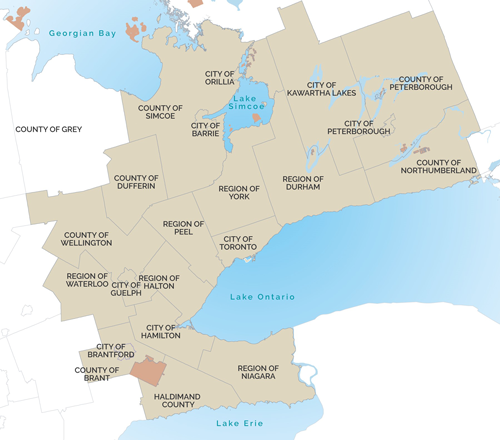
And added that: “To make sure that our policies put people first, we are updating A Place to Grow: Growth Plan for the Greater Golden Horseshoe. It is the product of a broad consultation where we heard from more than 1,100 people and received more than 650 submissions. We heard the government should facilitate the building of affordable housing options near transit to prevent sprawl and protect agricultural lands. The plan will help manage growth so communities in the region develop in ways that expand economic opportunity, while maintaining protections for our environmentally sensitive areas, including the Greenbelt, cultural heritage assets, and key employment and agricultural lands.
“We need to build more housing that people can afford so people have places to live near stable, reliable employment. That’s why we’re creating provincially significant employment zones to make sure that businesses – from manufacturers and industrial parks to high-tech offices – have room to grow.
 Toronto Star headline What do they plan to do?
“Across Ontario, there are empty-nesters who want to downsize, but they can’t find or afford the home they need near family and friends. If they could, it might free up a larger home for a young couple looking for a house with more space for their growing family, close to a park and a great school. Instead, everyone feels stuck.
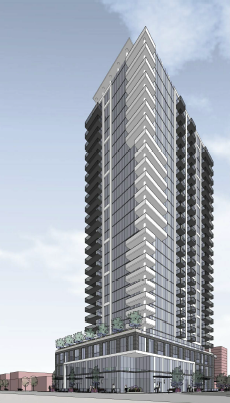 Approved – across the street from city hall – with the block to the immediate south awaiting a development that will want the same heiight. “It can take years of paperwork before a shovel ever breaks ground on a new housing project. Some government policies and processes are duplicated and can create delays for no reason, which drives up costs for home buyers.
“That’s why we’re reviewing every step of the development process and every policy, regulation and piece of legislation to eliminate unnecessary steps, duplication and barriers. We are cutting red tape and as we do, we are holding firm to our commitment to ensure the health and safety of Ontarians, and protect the environment, agricultural lands and our rich natural heritage.
Making it easier to build new housing
bring housing to market faster by speeding up local planning decisions and making the appeals process more efficient
make it easier for homeowners to create residential units above garages, in basements and in laneways
help build housing, including affordable housing, near transit
help municipalities implement community planning permit systems (e.g. in major transit station areas and provincially significant employment zones), which will streamline planning approvals to 45 days
simplify how funds are collected for community benefits such as parks and daycares
make upfront development costs easier to predict
give communities and developers more certainty on what they can build, and where they can build it
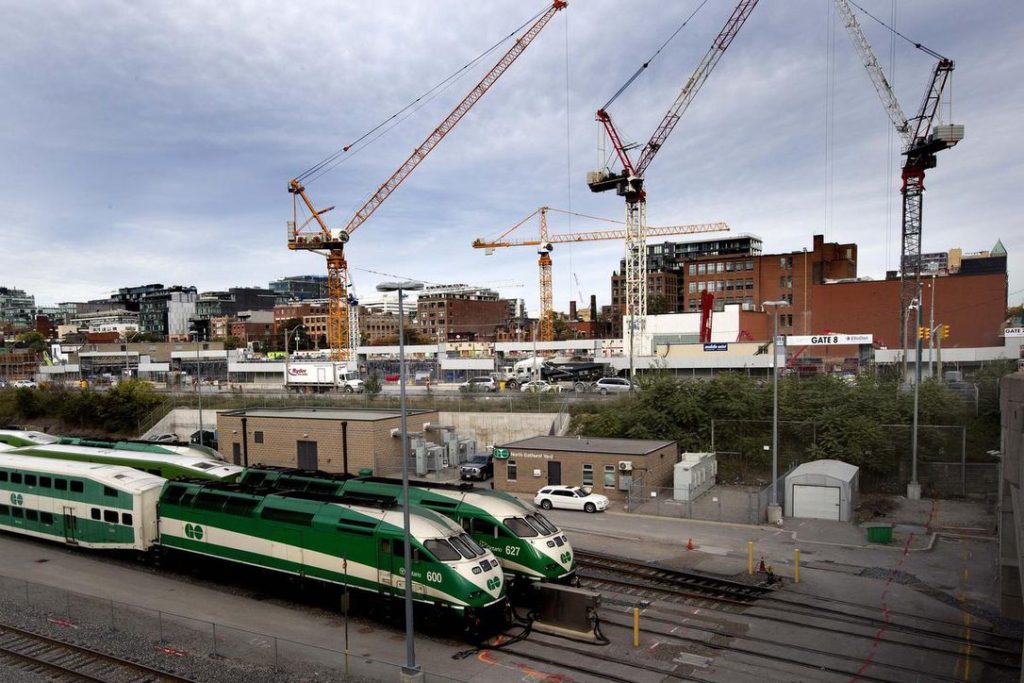 Increased GO train service and high rise towers – all about being open for business. “An item sent to the Local Planning Appeal Tribunal is still waiting for a decision, seven years later. That’s thousands of homes stuck in the pipeline, waiting to be built, and seven years of rising costs. Getting rid of that backlog will bring new housing to market, today.
“Conflicts can arise during the process of land use planning. The Local Planning Appeal Tribunal hears these disputes, but there is a backlog of Ontario Municipal Board legacy cases — approximately 100,000 units are tied up in Toronto alone. There are also too many complex processes standing in the way of creating new housing.
The province is proposing changes that will:
hire more adjudicators to help address the backlog of legacy cases by investing $1.4 million in 2019-20
ensure the tribunal has the powers and resources needed to make more timely decisions
allow the tribunal to make the best planning decisions in the place of Council
charge different fees and move towards a cost recovery model, while allowing community groups and residents to maintain affordable access to the appeals process

 By Staff By Staff
May 2nd, 2019
BURLINGTON, ON
The provincial government announced a program that, they say, will allow all Ontarians to find a home that meets their needs and their budget.
The plan that was announced will:
Cut red tape to make it easier to build the right types of housing in the right places
Make housing more affordable
Help taxpayers keep more of their hard-earned dollars
“Housing innovation isn’t just about new designs and materials, it’s about creative partnerships too. By working together, non-profits, co-ops and the private sector can help solve Ontario’s housing crisis.
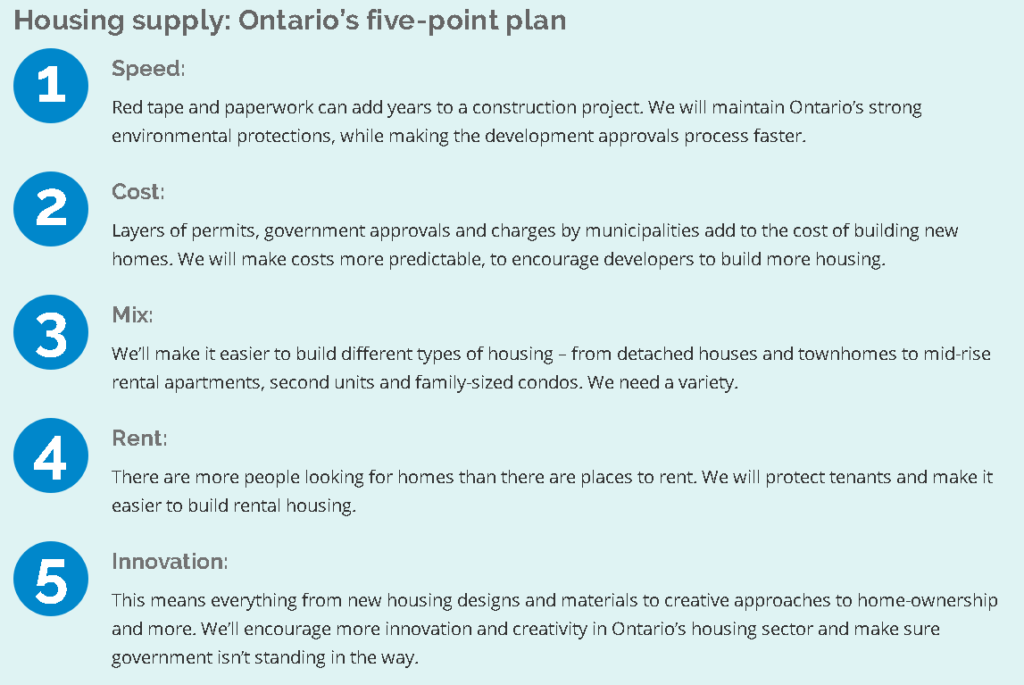 A 5 point plan – is it really that simple? “When individuals find a home, they are healthier and more productive. This benefits not only the individual, but also the province, as each person has the opportunity to contribute to our economy.
“More housing that meets people’s needs and budgets boosts Ontario’s economy by helping us keep jobs and support job creation. Businesses – from manufacturers to high tech firms – need employees, and those employees need affordable places to live. By making housing more affordable, businesses large and small will invest in Ontario again.
“More homes, more choice is about unlocking the development of all kinds of housing. From ownership to rental housing, whether built by private developers or non-profits, our action plan will help give people more choice and help bring costs down.
The plan is complemented by our Community Housing Renewal Strategy, which helps people with low and moderate incomes who can’t afford today’s high rents to find affordable housing. It will transform a fragmented and inefficient system into one that is more streamlined, sustainable and ready to help people who need it most.
It also includes early steps to improve community housing across the province:
helping tenants become economically self-sufficient
making it easier to predict and calculate rent
shortening waiting lists
helping people in greatest need
making community housing safer
We will work with municipalities and non-profits to sustain, repair and grow our community housing system.
Together, these plans respond to the diverse housing needs of all Ontarians.
What are they going to do for renters
 In today’s market, finding an affordable rental apartment can feel like winning the lottery. People are renting longer and more people are looking for a place to rent, but new construction has focused on condominiums rather than rental apartments. In today’s market, finding an affordable rental apartment can feel like winning the lottery. People are renting longer and more people are looking for a place to rent, but new construction has focused on condominiums rather than rental apartments.
Many people prefer to rent. But high home prices mean those who want to buy are also renting, or renting longer, which drives rents up. We need more housing – to own and to rent – to bring the market back to balance.
More homes, more choice will make it easier to build rental housing. For example, right now, home builders pay development charges up-front. A developer who builds a house and/or condominium builders can offset these development charges by preselling units. A developer who builds a rental unit can’t.
By postponing development charges until the buildings are rented, developers will be encouraged to start building rental housing again. More homes, more choice will also work to cut red tape around development approvals so new homes will be available to rent sooner.
Making it easier for landlords to navigate the complex building code approvals process will help create more rental housing. In Ontario, roughly 30,000 to 35,000 new homes are built each year, and many of them could include secondary suites, like basement apartments.
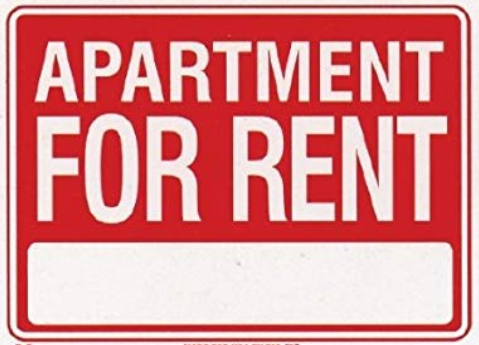 We’re encouraging small landlords to create new rental units too, by making it easier to build second suites (like basement apartments) and helping them navigate the complicated building code approvals process. We are also expanding development charge exemptions to include second units in new homes. We’re encouraging small landlords to create new rental units too, by making it easier to build second suites (like basement apartments) and helping them navigate the complicated building code approvals process. We are also expanding development charge exemptions to include second units in new homes.
As more rental units are built, tenants will have more choices and rents will decrease.
Creating more rental units is an essential part of our action plan. But once they have a place to live, renters shouldn’t have to worry about being treated unfairly or being unlawfully evicted. Ontario has strong protections for renters and we will do more to help tenants and landlords know their rights and how to resolve disputes.
Helping renters and landlords resolve disputes is the role of the Landlord and Tenant Board, but a shortage of adjudicators has created delays – average wait times are more than two months! The government is working with Tribunals Ontario on addressing shortages of adjudicators at the Landlord and Tenant Board. There have been a number of recent appointments and recruitment is underway to fill other adjudicator vacancies.
The government is also providing more than one billion dollars in 2019-20 to help sustain, repair and grow community housing and help end homelessness. Hundreds of organizations across Ontario have long-standing agreements to provide community housing to Ontario’s most vulnerable, and as many of these agreements approach their end, our government’s Community Housing Renewal Strategy will help them become more sustainable.
 Can this type of delay be brought to an end. The changes all have merit. A first read suggests that the delays, the red tape and the costs are all bunched at the municipal end of the spectrum.
There isn’t a thing the province can do about how effective the municipal bureaucracies are.
Skip over to the series of meetings on Red Tape and the attempt Mayor Meed Ward is making to roll out a Red Carpet for people who have to work with city hall to get a sense as to just how bad it is.
A couple of the more painful comments:
• City is too slow to react
• City staff have a lack of knowledge behind the scenes/of private sector and are unresponsive
• Staff are inconsistent in their application of policy
• Turnover of City staff

|
|
 By Pepper Parr
By Pepper Parr

























 In the media release the city sent out there is very little in terms of detail. The Gazette put together a lengthy piece setting out what the city wanted to get done in each of the five focus areas. That article can be accessed
In the media release the city sent out there is very little in terms of detail. The Gazette put together a lengthy piece setting out what the city wanted to get done in each of the five focus areas. That article can be accessed 





 Mary Lou Tanner, Deputy City Manager, the woman who gave the city the Grow Bold concept said: “The commitment from the Burlington Leadership Team and Burlington Council to work towards common objectives in partnership with our community is at the root of this important four-year plan.
Mary Lou Tanner, Deputy City Manager, the woman who gave the city the Grow Bold concept said: “The commitment from the Burlington Leadership Team and Burlington Council to work towards common objectives in partnership with our community is at the root of this important four-year plan.
 The defining feature of North American cities is the single-family detached home. It is the least efficient way to house people, yet municipal zoning laws have historically served to ensure its primacy.
The defining feature of North American cities is the single-family detached home. It is the least efficient way to house people, yet municipal zoning laws have historically served to ensure its primacy.




 We Love Burlington pressed Burlington MPP for comment on why she supported Bill 108.
We Love Burlington pressed Burlington MPP for comment on why she supported Bill 108.

 And then there was the friend that the Premier wanted to appoint as Commissioner of the Ontario Provincial Police. The blow back on that one was even fiercer. Someone else got that job.
And then there was the friend that the Premier wanted to appoint as Commissioner of the Ontario Provincial Police. The blow back on that one was even fiercer. Someone else got that job. Buck a beer fell off the radar screen.
Buck a beer fell off the radar screen.
 We have a public transportation system that does not meet the needs of the residents and certainly will not prevent people from using their cars. Free transportation from 9-2:30 Monday-Friday for seniors, while a nice thing to offer, is not the answer. It is a band aid approach to a more serious issue. Did you know that if someone takes a Handi-van into Hamilton, they have to change vans and get on a Hamilton Handi-Van to complete the journey? People who are eligible to use the Handi-Van have mobility and other medical conditions – and they have to change vans in all kinds of weather. Municipalities should have been working together, but they have not.
We have a public transportation system that does not meet the needs of the residents and certainly will not prevent people from using their cars. Free transportation from 9-2:30 Monday-Friday for seniors, while a nice thing to offer, is not the answer. It is a band aid approach to a more serious issue. Did you know that if someone takes a Handi-van into Hamilton, they have to change vans and get on a Hamilton Handi-Van to complete the journey? People who are eligible to use the Handi-Van have mobility and other medical conditions – and they have to change vans in all kinds of weather. Municipalities should have been working together, but they have not. For a few years I have said that the OMB/LPAT has to go. I now question if all Municipalities are able to act alone to meet Provincial Mandates. Developers are in the business to develop. It is the responsibility of Municipalities to have in place an Official Plan that meets the mandates of the Provincial Government. Some municipalities seem to have done this. It seems, unfortunately, that Burlington has not, and I question if any new Official Plan that is passed will stand the test.
For a few years I have said that the OMB/LPAT has to go. I now question if all Municipalities are able to act alone to meet Provincial Mandates. Developers are in the business to develop. It is the responsibility of Municipalities to have in place an Official Plan that meets the mandates of the Provincial Government. Some municipalities seem to have done this. It seems, unfortunately, that Burlington has not, and I question if any new Official Plan that is passed will stand the test. Penny Hersh was part of the driving force that created ECoB – Engaged Citizens of Burlington. She serves at the co-chair of ECoB
Penny Hersh was part of the driving force that created ECoB – Engaged Citizens of Burlington. She serves at the co-chair of ECoB This Carriage Gate development will inevitably be appealed to the new LPAT/OMB, an un-elected, un-answerable, faceless, undemocratic agency of government which will decide Burlington’s fate on this development, as it will on most of the other developments which will be coming to Council in the months and years ahead. With the passing of Bill 108 into law and the return of the rules of the old OMB, but with slashed timelines, the minor improvements in planning procedure achieved by the introduction of the LPAT have been lost.
This Carriage Gate development will inevitably be appealed to the new LPAT/OMB, an un-elected, un-answerable, faceless, undemocratic agency of government which will decide Burlington’s fate on this development, as it will on most of the other developments which will be coming to Council in the months and years ahead. With the passing of Bill 108 into law and the return of the rules of the old OMB, but with slashed timelines, the minor improvements in planning procedure achieved by the introduction of the LPAT have been lost.
 Roland Tanner, PhD, is co-chair of ECoB and was a member of the Shape Burlington report committee.
Roland Tanner, PhD, is co-chair of ECoB and was a member of the Shape Burlington report committee.




 We Love Burlington had quite a bit more to say on the bill and provided much more detail.
We Love Burlington had quite a bit more to say on the bill and provided much more detail.








 Gary Scobie is a frequent commentator on how Burlington can grow – he advocates for responsible and thoroughly thought through growth.
Gary Scobie is a frequent commentator on how Burlington can grow – he advocates for responsible and thoroughly thought through growth.









 “Keith Hoey, outgoing President of the Burlington Chamber of Commerce (15 years now), focuses on: a) connecting people through networking and events; b) educating businesses on things like managing their books or understanding government decisions that will impact them; c) advocating with all levels of government on behalf of business owners; and d) providing discounts and savings to help businesses save money.” A Prince who has earned retirement and will be missed – those shoes are going to be hard to fill.
“Keith Hoey, outgoing President of the Burlington Chamber of Commerce (15 years now), focuses on: a) connecting people through networking and events; b) educating businesses on things like managing their books or understanding government decisions that will impact them; c) advocating with all levels of government on behalf of business owners; and d) providing discounts and savings to help businesses save money.” A Prince who has earned retirement and will be missed – those shoes are going to be hard to fill.






 The first was during the Statutory meeting on the development proposal for 411 Maple Avenue where the operator of a long term care nursing home wants to sell the property to a developer and use the proceeds from that sale to build a new long term care retirement home in the Alton community.
The first was during the Statutory meeting on the development proposal for 411 Maple Avenue where the operator of a long term care nursing home wants to sell the property to a developer and use the proceeds from that sale to build a new long term care retirement home in the Alton community.


 The next focus group will include several contributors from the rural business ecosystem who sit on the newly formed Agriculture and Rural Affairs Committee with the City of Burlington.
The next focus group will include several contributors from the rural business ecosystem who sit on the newly formed Agriculture and Rural Affairs Committee with the City of Burlington.




 In today’s market, finding an affordable rental apartment can feel like winning the lottery. People are renting longer and more people are looking for a place to rent, but new construction has focused on condominiums rather than rental apartments.
In today’s market, finding an affordable rental apartment can feel like winning the lottery. People are renting longer and more people are looking for a place to rent, but new construction has focused on condominiums rather than rental apartments. We’re encouraging small landlords to create new rental units too, by making it easier to build second suites (like basement apartments) and helping them navigate the complicated building code approvals process. We are also expanding development charge exemptions to include second units in new homes.
We’re encouraging small landlords to create new rental units too, by making it easier to build second suites (like basement apartments) and helping them navigate the complicated building code approvals process. We are also expanding development charge exemptions to include second units in new homes.




